7.1: Early Periods in Greek History
7.1.1: Greek Dark Ages
The Greek Dark Ages were ushered in by a period of violence, and characterized by the disruption of Greek cultural progress.
Learning Objective
Understand the characteristics of the Greek Dark Ages
Key Points
- The Late Bronze Age collapse, also known as the Age of
Calamities, was a transition in the Aegean Region, Eastern Mediterranean, and
Southwestern Asia. It took place from the Late Bronze Age to the Early Iron
Age. Historians believe this period was violent, sudden, and culturally
disruptive. - Many historians attribute the fall of the
Mycenaeans, and overall Bronze Age collapse, to climatic or environmental
catastrophe combined with an invasion by the Dorians (or Sea Peoples). - During the Dark Ages, Greece was most likely divided into independent
regions according to kinship groups, and the oikoi, or
households. - Toward the end of the Greek Dark Ages,
communities began to develop that were governed by elite groups of aristocrats, as opposed to singular kings or chieftains of earlier periods. Additionally, trade with
other communities in the Mediterranean and the Levant began to strengthen, based
upon findings from archaeological sites.
Key Terms
- oikoi
-
The
basic unit of society in most Greek city-states. In some usage, it refers to
the line of descent from a father to a son throughout generations.
Alternatively, it can refer to everybody living in a given house. - Linear B
-
Syllabic
script that was used for writing Mycenaean Greek, the earliest documented form
of the Greek language. - palace
economy -
A
system of economic organization in which a substantial share of wealth flows
into the control of a centralized administration (i.e., the palace), and then
outward to the general population.
Age of Calamities
The Late Bronze Age collapse, or Age of Calamities, was a
transition in the Aegean Region, Eastern Mediterranean, and Southwestern Asia
that took place from the Late Bronze Age to the Early Iron Age. Historians
believe this period was violent, sudden, and culturally disruptive. The palace
economy of the Aegean Region that had characterized the Late Bronze Age, was
replaced, after a hiatus, by the isolated village cultures of the Greek Dark
Ages—
a period that lasted for more than 400 years. Cities like Athens
continued to be occupied, but with a more local sphere of influence, limited
evidence of trade, and an impoverished culture, which took centuries to
recover.
Fall of the Mycenaeans
Many historians attribute the fall of the Mycenaeans, and
overall Bronze Age collapse, to climatic or environmental catastrophe, combined
with an invasion by the Dorians or Sea Peoples—a group of people who possibly
originated from different parts of the Mediterranean like the Black Sea, though
their origins remain obscure. Historians also point to the widespread
availability of edged iron weapons as an exasperating factor. Despite this, no
single explanation fits all available archaeological evidence in explaining the
fall of the Mycenaean culture.
Many large-scale revolts took place in several parts of the
eastern Mediterranean during this time, and attempts to overthrow existing
kingdoms were made as a result of economic and political instability by peoples
already plagued with famine and hardship. Some regions in Greece, such as
Attica, Euboea, and central Crete, recovered economically quicker from these
events than other regions, but life for the poorest Greeks would have remained
relatively unchanged. Farming, weaving, metalworking, and potting continued at
lower levels of output and for local use. Some technical innovations were
introduced around 1050 BCE with the start of the Proto-geometric style. However, the overall trend was toward simpler, less intricate pieces with fewer
resources being devoted to the creation of art.
None of the Mycenaean palaces of the Late Bronze Age
survived, with the possible exception of the Cyclopean fortifications on the
Acropolis of Athens. The archaeological record shows that destruction was
heaviest at palaces and fortified sites. Up to 90% of small sites in the
Peloponnese were abandoned, suggesting major depopulation. The Linear B writing
of the Greek language used by Mycenaean bureaucrats ceased, and decorations on
Greek pottery after about 1100 BCE lacks the figurative decoration of the
Mycenaeans, and was restricted to simpler geometric styles.
Society During the Greek Dark Ages
Greece was most likely divided into independent regions according to kinship groups and the oikoi, or households. Excavations of Dark Age
communities, such as Nichoria in the Peloponnese, have shown how a Bronze Age
town was abandoned in 1150 BCE, but then reemerged as a small village cluster
by 1075 BCE. Archaeological evidence suggests that only 40 families lived in
Nichoria and that there was abundant farming and grazing land. Some remains
appear to have been the living quarters of a chieftain. High status
individuals did exist during the Dark Ages; however, their standards of living
were not significantly higher than others in their village.
By the mid- to late 8th century BCE, a new alphabet system
was adopted by the Greek, and borrowed from the Phoenician writing system. This
writing system introduced characters for vowel sounds, creating the first truly
alphabetic (as opposed to abjad) writing system. The new system of writing
spread throughout the Mediterranean, and was used not only to write in Greek,
but also Phrygian and other languages.
It was previously believed that all contact had
been lost between mainland Hellenes and foreign powers during this period;
however, artifacts from excavations at Lefkandi in Euboea show that significant
cultural and trade links with the east, especially the Levant coast, developed
from approximately 900 BCE onward. Evidence has also emerged of a Hellenic
presence in sub-Mycenaean Cyprus, and on the Syrian coast at Al Mina. The
archaeological record of many sites demonstrates that the economic recovery of
Greece was well advanced by the beginning of the 8th century BCE. Many burial
sites contained offerings from the Near East, Egypt, and Italy. The decoration
of pottery also became more elaborate, featuring figured scenes that parallel
the stories of Homeric tradition. Iron tools and weapons also became better in
quality, and communities began to develop that were governed by elite groups of
aristocrats, as opposed to singular kings or chieftains of earlier periods.
7.1.2: Archaic Greece
The
Archaic Period saw the increasing urbanization of Greek communities, and the
development of the concept of the polis.
Learning Objective
Understand the changes to Greek society during the Archaic Period
Key Points
- The Archaic period saw significant urbanization, and the development of the concept of the polis, as it was used in classical
Greece. - Archaic Greece, from the mid-seventh century
onward, has been referred to as an “age of tyrants.” - The Homeric Question concerns the doubts and
consequent debate over the historicity of the Iliad and the Odyssey, as well as the identity of their author, Homer.
Key Terms
- synoecism
-
The
amalgamation of several small settlements into a single urban center. - polis
-
The
literal translation of this word from Greek is “city.” It typically refers to
the Greek city-states of the Archaic and Classical periods.
Archaic Greece
The Archaic period of Greek history lasted from the 8th
century BCE to the second Persian invasion of Greece in 480 BCE. The period
began with a massive increase in the Greek population and a structural
revolution that established the Greek city-states, or polis. The Archaic
period saw developments in Greek politics, economics, international relations,
warfare, and culture. It also laid the groundwork for the classical period,
both politically and culturally. During this time, the Greek alphabet developed, and the earliest surviving Greek literature was composed. Monumental sculpture
and red-figure pottery also developed in Greece, and in Athens, the earliest
institutions of democracy were implemented.
Some written accounts of life exist from this time period in
the form of poetry, law codes, inscriptions on votive offerings, and epigrams
inscribed on tombs. However, thorough written histories, such as those that
exist from the Greek classical period, are lacking. Historians do have access
to rich archaeological evidence from this period, however, that informs our
understanding of Greek life during the Archaic period.
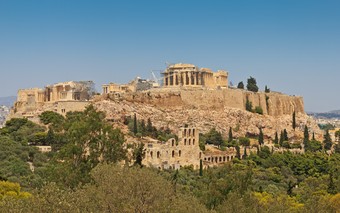
View from Philopappos, Acropolis Hill
The Acropolis of Athens, a noted polis of classical Greece.
Development of the Polis
The Archaic period saw significant urbanization and the
development of the concept of the polis as it was used in classical Greece. However,
the polis did not become the dominant form of sociopolitical organization
throughout Greece during the Archaic period, and in the north and west of the
country it did not become dominant until later in the classical period. The
process of urbanization known as “synoecism” (or the amalgamation of several
small settlements into a single urban center), took place in much of Greece
during the 8th century. Both Athens and Argos, for example, coalesced into
single settlements near the end of that century. In some settlements, physical
unification was marked by the construction of defensive city walls. The
increase in population, and evolution of the polis as a sociopolitical structure, necessitated a new form of political organization.
Age of Tyranny
Archaic Greece from the mid-7th century onward has been
referred to as an “age of tyrants.” Various explanations have been provided for
the rise of tyranny in the 7th century. The most popular explanation dates
back to Aristotle, who argued that tyrants were set up by the people in response
to the nobility becoming less tolerable. Because there is no evidence from this
time period demonstrating this to be the case, historians have looked for
alternate explanations. Some argue that tyrannies were set up by individuals
who controlled privates armies, and that early tyrants did not need the support
of the people at all. Others suggest that tyrannies were established as a
consequence of in-fighting between rival oligarchs, rather than as a result of
fighting between oligarchs and the people.
Other historians question the existence of a 7th century “age of tyrants” altogether. In the Archaic period, the Greek word tyrannos did
not have the negative connotations it had later in the classical period. Often
the word could be used as synonymous with “king.” As a result, many historians
argue that Greek tyrants were not considered illegitimate rulers, and cannot be
distinguished from any other rulers during the same period.
The Homeric Question
The Homeric Question concerns the doubts and
consequent debate over the identity of Homer, the author of the Iliad and the
Odyssey; it also questions the historicity of the two books. Many scholars agree that regardless of who
authored Homer’s works, it is highly likely that the poems attributed to him
were part of a generations-old oral tradition, with many scholars believing the
works to be transcribed some time in the 6th century BCE or earlier. Many
estimates place the events of Homer’s Trojan War as preceding the Greek Dark
Ages, of approximately 1250 to 750 BCE. The Iliad, however, has been placed
immediately following the Greek Dark Age period.
7.1.3: The Rise of Classical Greece
Classical Greece rose after the fall of the Athenian tyrants and the institution of Cleisthenes’ democratic reforms, and lasted throughout the 5th and 4th centuries BCE.
Learning Objective
Understand the significance of Cleisthenes’ reforms to the rise of Classical Greece
Key Points
- The classical period followed the Archaic period, and was succeeded by the Hellenistic period.
- Much of modern Western politics, artistic and scientific thought, literature, and philosophy derives from this period of Greek history.
- Through Cleisthenes’ reforms, the people endowed their city with isonomic institutions, and established ostracism.
- A corpus of reforms made to Athenian political administration during this time led to the emergence of a wider democracy in the 460s and 450s BCE.
Key Terms
- Classical Greece
-
A 200 year period in Greek culture, lasting from the 5th through 4th centuries BCE.
- Cleisthenes
-
A noble Athenian of the Alcmaeonid family, credited with reforming the constitution of ancient Athens, and setting it on a democratic footing in 508/7 BCE.
- isonomic
-
A word used by ancient Greek writers to refer to various kinds of popular government with the general goal of “equal rights.”
- ostracism
-
A procedure under Athenian democracy by which any citizen could be expelled from the city-state of Athens for ten years.
- trittyes
-
Population divisions in ancient Attica, established by the reforms of Cleisthenes in 508 BCE.
Classical Greece was a 200-year period in Greek culture lasting from the 5th to the 4th centuries BCE. This period saw the annexation of much of modern-day Greece by the Persian Empire, as well as its subsequent independence. Classical Greece also had a powerful influence on the Roman Empire, and greatly influenced the foundations of Western civilization. Much of modern Western politics, artistic and scientific thought, literature, and philosophy derives from this period of Greek history. The classical period was preceded by the Archaic period, and was succeeded by the Hellenistic period.
Rise
of the City-States
The
term “city-state,” which is English in origin, does not fully translate the
Greek term for these same entities, polis.
Poleis were different from ancient
city-states in that they were ruled by bodies of the citizens who lived there.
Many were initially established, as in Sparta, via a network of villages, with a
governance center being established in a central urban center. As notions of
citizenship rose to prominence among landowners, polis came to embody an entire body of citizens and the term could
be used to describe the populace of a place, rather than the physical location
itself. Basic elements of a polis
often included the following:
- Self-governance,
autonomy, and independence -
A
social hub and financial marketplace, called an agora -
Urban
planning and architecture -
Temples,
altars, and other sacred precincts, many of which would be dedicated to the
patron deity of the city -
Public
spaces, such as gymnasia and theaters -
Defensive
walls to protect against invasion -
Coinage minted by the city
Polis
were established and expanded by synoecism, or the absorption of nearby
villages and tribes. Most cities were composed of several tribes that were in
turn composed of groups sharing common ancestry, and their extended families.
Territory was a less helpful means of thinking about the shape of a polis than regions of shared religious
and political associations.
Dwellers
of a polis were typically divided
into four separate social classes, with an individual’s status usually being
determined at birth. Free adult men born of legitimate citizens were considered
citizens with full legal and political rights, including the right to vote, be
elected into office, and bear arms, with the obligation to serve in the army
during wartime. The female relatives and underage children of full citizens
were also considered citizens, but they had no formal political rights. They
were typically represented within society by their adult male relatives. Citizens
of other poleis who chose to reside
in a different polis possessed full
rights in their place of origin, but had no political rights in their new place
of residence. Otherwise, such citizens had full personal and property rights
subject to taxation. Finally, slaves were considered possessions of their owner
and had no rights or privileges other than those granted by their owner.
Greco-Persian
Wars
The
Greco-Persian Wars, also referred to as the Persian Wars, were a series of
conflicts that began in 499 BCE and lasted until 449 BCE, between the Achaemenid Empire of Persia (modern-day Iran) and Greek
city-states. The conflict began
when Cyrus the Great conquered the Greek-inhabited region of Ionia in 547 BCE.
After struggling to control the cities of Ionia, the Persians appointed tyrants
to rule each of them. When the tyrant of Miletus embarked on an unsuccessful expedition
to conquer the island of Naxos with Persian support, however, a rebellion was
incited throughout Hellenic Asia Minor against the Persians. This rebellion,
known as the Ionian Revolt, lasted until 493 BCE, and drew increasingly more
regions throughout Asia Minor into the conflict.
Eventually
the Ionians suffered a decisive defeat and the rebellion collapsed.
Subsequently, Darius the Great, the Persian ruler, sought to secure his empire
from further revolts and interference from the mainland Greeks, and embarked
upon a scheme to conquer all of Greece. The first Persian invasion of Greece
began in 492 BCE, and was successful in conquering Macedon and re-subjugating
Thrace. In 490 BCE, a second force was sent to Greece across the Aegean Sea,
successfully subjugating the Cyclades. However, the Persians were defeated by the
Athenians at the Battle of Marathon, putting a halt to Darius’s plan until his
death in 486 BCE.
In
480 BCE, Darius’s son, Xerxes, personally led the second Persian invasion of
Greece with one of the largest ancient armies ever assembled. His invasion was
successful and Athens was burned. However, the following year, the Allied
Greek states went on the offensive, defeating the Persian army at the Battle of
Plataea and ending the invasion of Greece. The Greeks continued to expel
Persian forces from Greece and surrounding areas, but the actions of Spartan
General Pausanias at the siege of Byzantium alienated many of the Greek states
from the Spartans, causing the anti-Persian alliance to be reconstituted around
Athenian leadership in what became known as the Delian League. The Delian
League continued the campaign against the Persians for the next three decades.
Some historical sources suggest the end of hostilities between the Greeks and
the Persians was marked by a peace treaty between Athens and Persia, called the
Peace of Callias.
Athenian Democracy
Athenian democracy
developed around the 5th century BCE, in the Greek city-state of Athens. It is
the first known democracy in the world. Other Greek cities set up democracies,
most following the Athenian model, but none are as well documented as Athens. Athenian
democracy was a system of direct democracy, in which participating citizens
voted directly on legislation and executive bills. Participation was open to adult,
land-owning men, which historians estimate numbered between 30,000 and 50,000
individuals, out of a total population of approximately 250,000 to 300,000.
Before the first attempt at
democratic government, Athens was ruled by a series of archons, or chief
magistrates, and the Areopagus, which was made up of ex-archons. Archons were typically
aristocrats who ruled to their own advantage. Additionally, a series of
laws codified by Draco in 621 BCE reinforced the power of the aristocracy over
all other citizens. A mediator called Solon reshaped the city-state by
restructuring the way citizenship was defined in order to absorb the
traditional aristocracy within it, and established the right of every Athenian to
participate in meetings of governing assemblies. The Areopagus, however,
retained ultimate lawmaking authorities.
Cleisthenes
In 510 BCE, Spartan troops helped the Athenians overthrow their king, the tyrant Hippias, son of Peisistratos. Cleomenes I, king of Sparta, put in place a pro-Spartan oligarchy headed by Isagoras. But his rival, Cleisthenes, with the support of the middle class and aided by democrats, managed to take over. Cleomenes intervened in 508 and 506 BCE, but could not stop Cleisthenes, who was then supported by the Athenians. Through his reforms, the people endowed their city with institutions furnished with equal rights (i.e., isonomic institutions), and established ostracism,
a
procedure by which any citizen could be expelled from the city-state of Athens
for ten years.
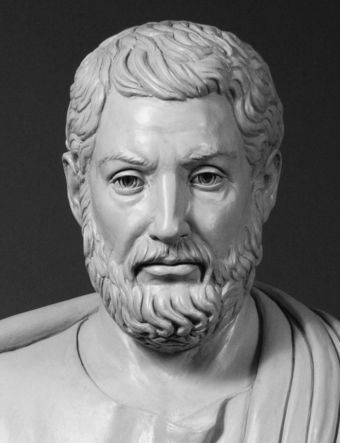
Bust of Cleisthenes
Modern bust of Cleisthenes, known as “the father of Athenian democracy,” on view at the Ohio Statehouse, Columbus, Ohio. Cleisthenes, the father of Greek democracy, reformed traditional Athenian government controlled by ruling tribes into the first government “of the people” (a demos, or democracy).
The isonomic and isegoric democracy was first organized into about 130 demes— political subdivisions created throughout Attica. Ten thousand citizens exercised their power via an assembly (the ekklesia, in Greek), of which they all were a part, that was headed by a council of 500 citizens chosen at random. The city’s administrative geography was reworked, the goal being to have mixed political groups—not federated by local interests linked to the sea, the city, or farming—whose decisions (declaration of war, etc.) would depend on their geographical situations. The territory of the city was subsequently divided into 30 trittyes. It was this corpus of reforms that would allow the emergence of a wider democracy in the 460s and 450s BCE.
7.2: Sparta
7.2.1: Sparta
Sparta, known for its militaristic culture and unequaled women’s rights, was a dominant military power in classical Greece.
Learning Objective
Distinguish key differences between Athens and Sparta
Key Points
- Sparta was a prominent city-state in ancient Greece, situated on the banks of the Eurotas River in Laconia in southeastern Peloponnese.
- Given its military preeminence, Sparta was recognized as the overall leader of the combined Greek forces during the Greco-Persian Wars, and defeated Athens during the Peloponnesian War.
- Sparta’s defeat by Thebes in the Battle of Leuctra in 371 BCE ended Sparta’s prominent role in Greece, but it maintained its political independence until the Roman conquest of Greece in 146 BCE.
- Sparta functioned under an oligarchy of two hereditary kings.
- Unique in ancient Greece for its social system and constitution, Spartan society focused heavily on military training and excellence.
- Spartan women enjoyed status, power, and respect that was unequaled in the rest of the classical world.
Key Terms
- Sparta
-
A prominent city-state in ancient Greece situated on the banks of the Eurotas River in Laconia. The dominant military power in ancient Greece.
- agoge
-
The rigorous education and training regimen mandated for all male Spartan citizens, except for the firstborn sons of the ruling houses Eurypontid and Agiad.
Sparta was a prominent city-state in ancient Greece situated on the banks of the Eurotas River in Laconia in southeastern Peloponnese. It emerged as a political entity around the 10th century BCE, when the invading Dorians subjugated the local, non-Dorian population. Around 650 BCE, it rose to become the dominant military power in ancient Greece. Given its military preeminence, Sparta was recognized as the overall leader of the combined Greek forces during the Greco-Persian Wars. Between 431 and 404 BCE, Sparta was the principal enemy of Athens during the Peloponnesian War, from which it emerged victorious, though at great cost. Sparta’s defeat by Thebes in the Battle of Leuctra in 371 BCE ended Sparta’s prominent role in Greece. However, it maintained its political independence until the Roman conquest of Greece in 146 BCE.
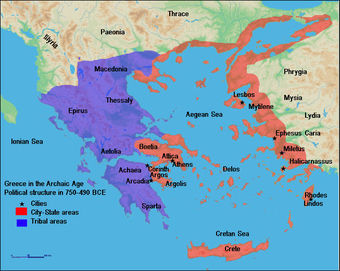
Political geography of ancient Greece
The map shows the political structure of Greece in the Archaic Age.
The Rise of Classical Sparta
The Spartans were already considered a land-fighting force to
be reckoned with when, in 480 BCE, a small force of Spartans, Thespians, and
Thebans made a legendary final stand at the Battle of Thermopylae against the
massive Persian army during the Greco-Persian Wars. The Greek forces suffered
very high casualties before finally being encircled and defeated. One year
later, Sparta led a Greek alliance against the Persians at the Battle of Plataea
where their superior weaponry, strategy, and bronze armor proved a huge asset
in achieving a resounding victory. This decisive victory put an end to the
Greco-Persian War, as well as Persian ambitions of spreading into Europe.
Despite being fought as part of a alliance, the victory was credited to Sparta,
which had been the de facto leader of the entire Greek expedition.
In the later
classical period, Sparta fought amongst Athens, Thebes, and Persia for
supremacy within the region. As a result of the Peloponnesian War, Sparta
developed formidable naval power, enabling it to subdue many key Greek states
and even overpower the elite Athenian navy. A period of Spartan Hegemony was
inaugurated at the end of the 5th century BCE, when Sparta defeated
the Athenian Empire and invaded Persian provinces in Anatolia.
Spartan Culture and Government
Sparta functioned under an oligarchy. The state was ruled by two hereditary kings of the Agiad and Eurypontid families, both supposedly descendants of Heracles, and equal in authority so that one could not act against the power and political enactments of his colleague. Unique in ancient Greece for its social system and constitution, Spartan society was completely focused on military training and excellence. Its inhabitants were classified as Spartiates (Spartan citizens who enjoyed full rights), Mothakes (non-Spartan, free men raised as Spartans), Perioikoi (freed men), and Helots (state-owned serfs, part of the enslaved, non-Spartan, local population).
Male Spartans began military training at age seven. The training was designed to encourage discipline and physical toughness, as well as emphasize the importance of the Spartan state. Boys lived in communal messes and, according to Xenophon, whose sons attended the agoge, the boys were fed “just the right amount for them never to become sluggish through being too full, while also giving them a taste of what it is not to have enough.” Besides physical and weapons training, boys studied reading, writing, music, and dancing. Special punishments were imposed if boys failed to answer questions sufficiently laconically (i.e., briefly and wittily).
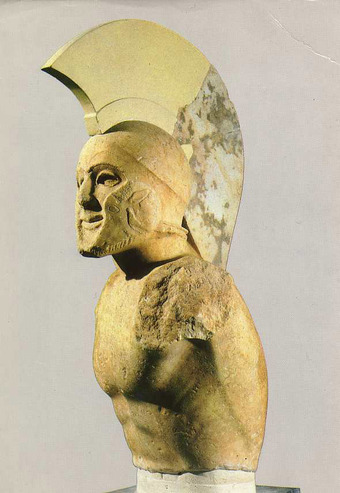
Spartan Hoplite
Marble statue of a helmed hoplite (5th century BCE), Archaeological Museum of Sparta, Greece.
At age 20, the Spartan citizen began his membership in one of the syssitia (dining messes or clubs), which were composed of about 15 members each, and were compulsory. Here each group learned how to bond and rely on one another. The Spartans were not eligible for election to public office until the age of 30. Only native Spartans were considered full citizens, and were obliged to undergo military training as prescribed by law, as well as participate in, and contribute financially to, one of the syssitia.
Spartan Women
Female Spartan citizens enjoyed status, power, and respect that was unequaled in the rest of the classical world. The higher status of females in Spartan society started at birth. Unlike in Athens, Spartan girls were fed the same food as their brothers. Nor were they confined to their father’s house or prevented from exercising or getting fresh air. Spartan women even competed in sports. Most important, rather than being married at the age of 12 or 13, Spartan law forbade the marriage of a girl until she was in her late teens or early 20s. The reasons for delaying marriage were to ensure the birth of healthy children, but the effect was to spare Spartan women the hazards and lasting health damage associated with pregnancy among adolescents.
Spartan women, better fed from childhood and fit from exercise, stood a far better chance of reaching old age than their sisters in other Greek cities, where the median life expectancy was 34.6 years, or roughly ten years below that of men. Unlike Athenian women, who wore heavy, concealing clothes and were rarely seen outside the house, Spartan women wore dresses (peplos) slit up the side to allow freer movement, and moved freely about the city, either walking or driving chariots.
7.2.2: Culture in Classical Sparta
Although
Spartan society was highly regimented, militarily and socially, enslaved classes
and women were afforded greater privileges relative to the populations of other
Greek city-states.
Learning Objective
Understand the key characteristics of Sparta’s society
Key Points
- Sparta was an oligarchic city-state, ruled by two
hereditary kings equal in authority. - Spartan society was largely structured around
the military, and around military training. - Inhabitants were classified as Spartiates
(Spartan citizens, who enjoyed full rights), Mothakes (non-Spartan, free men
raised as Spartans), Perioikoi (free, but non-citizen inhabitants), and Helots
(state-owned serfs, part of the enslaved non-Spartan, local population). - Spartiates began military training at the age of
seven. - At the age of 20, Spartiates were initiated
into full citizenship and joined a syssitia. - Helots were granted
many privileges, in comparison to enslaved populations in other Greek city-states. - The Helot population
outnumbered the Spartiate population, and grew over time, causing societal
tensions. - Female Spartans enjoyed status, power, and respect
that was unequaled in the rest of the classical world.
Key Terms
- ephors
-
Ephors
were ancient Spartan officials who shared power with the hereditary kings. Five
individuals were elected annually to swear on behalf of the city, whereas kings
served for a lifetime and swore only on their own behalf. - gerousia
-
The
gerousia were a council of Spartan elders comprised of men over the age of 60, who were elected for life, and usually were members of one of the two kings’
households. - Delphi
-
A famous
ancient sanctuary that served as the seat of an oracle, who consulted on
important decisions throughout the ancient classical world.
The Spartan Political System
Sparta functioned under an
oligarchy. The state was ruled by two hereditary kings of the Agiad and
Eurypontid families, both supposedly descendants of Heracles, and equal in
authority so that one could not act against the power and political enactments
of his colleague. The duties of the kings were religious, judicial, and
military in nature. They were the chief priests of the state, and maintained
contact with Delphi, the sanctuary that exercised great authority in Spartan
politics.
By 450 BCE, the kings’ judicial
authority was restricted to cases dealing with heiresses, adoptions, and public
roads. Over time, royal prerogatives were curtailed further until, aside
from their service as military generals, the kings became mere figureheads. For
example, from the time of the Greco-Persian Wars, the kings lost the right to
declare war and were shadowed in the field by two officials, known as ephors. The ephors also
supplanted the kings’ leadership in the realm of foreign policy. Civil and
criminal cases were also decided by ephors, as well as a council of 28 elders
over the age of 60, called the gerousia.
The gerousia were elected for life, and usually were members of one of the two kings’ households. The gerousia discussed high state policy
decisions, then proposed action alternatives to the damos—a collective body of Spartan citizenry, who would then
select one of the options by voting.
Spartan Citizenship
Unique in ancient Greece for its
social system, Spartan society was completely focused on military training and
excellence. Its inhabitants were classified as Spartiates (Spartan citizens,
who enjoyed full rights), Mothakes (non-Spartan, free men raised as Spartans),
Perioikoi (free, but non-citizen inhabitants), and Helots (state-owned serfs, part of the
enslaved, non-Spartan, local population).
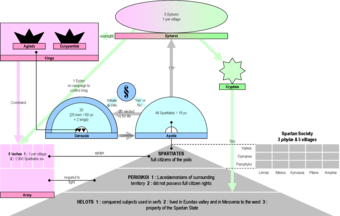
Structure of Spartan society
Spartan society was highly regimented, with a clearly delineated class system.
Male Spartans began military
training at age seven. The training was designed to encourage discipline and physical
toughness, as well as emphasize the importance of the Spartan state. Typically
only men who were to become Spartiates underwent military training, although
two exceptions existed to this rule. Trophimoi,
or “foster sons,” from other Greek city-states were allowed to attend training
as foreign students. For example, the Athenian general Xenophon sent his two
sons to Sparta as trophimoi.
Additionally, sons of a Helot could enroll as a syntrophos if a Spartiate formally adopted him and paid his way. If
a syntrophos did exceptionally well
in training, he could be sponsored to become a Spartiate. Likewise, if a Spartan
could not afford to pay the expenses associated with military training, they
potentially could lose their right to citizenship.
Boys who underwent training lived
in communal messes and, according to Xenophon, whose sons attended the agoge, the boys were
fed “just the right amount for them never to become sluggish through being
too full, while also giving them a taste of what it is not to have
enough.” Besides physical and weapons training, boys studied reading,
writing, music, and dancing. Special punishments were imposed if boys failed to
answer questions sufficiently laconically (i.e., briefly and wittily).
At age 20, the Spartan citizen began his membership in one of the syssitia (dining messes or clubs), which were
composed of about 15 members each, and were compulsory. Here each group learned
how to bond and rely on one another. The Spartans were not eligible for
election to public office until the age of 30. Only native Spartans were
considered full citizens, and were obliged to undergo military training as
prescribed by law, as well as participate in, and contribute financially to, one
of the syssitia.
Helots
Spartiates
were actually a minority within Sparta, and Helots made up the largest class of
inhabitants of the city-state. Helots were originally free Greeks that the
Spartans had defeated in battle, and subsequently enslaved. In contrast to
populations conquered by other Greek cities, the male Helot population was not
exterminated, and women and children were not treated as chattel. Instead,
Helots were given a subordinate position within Spartan society more comparable
to the serfs of medieval Europe. Although Helots did not have voting rights,
they otherwise enjoyed a relatively privileged position, in comparison to slave
populations in other Greek city-states.
The
Spartan poet, Tyrtaios, gives account that Helots were permitted to marry and retain
half the fruits of their labor. They were also allowed religious freedoms and
could own a limited amount of personal property. Up to 6,000 Helots even
accumulated enough wealth to buy their own freedom in 227 BCE.
Since
Spartiates were full-time soldiers, manual labor fell to the Helot population
who worked as unskilled serfs, tilling the Spartan land or accompanying the
Spartan army as non-combatants. Helot women were often used as wet nurses.
Relations between Helots and their Spartan masters were often strained, and
there is evidence that at least one Helot revolt occurred circa 465-460 BCE.
Many historians argue that because the Helots were permitted such privileges as
the maintenance of family and kinship groups and ownership of property, they
were better able to retain their identity as a conquered people and thus were
more effective at organizing rebellions. Over time, the Spartiate population
continued to decline and the Helot population grew, and the imbalance in power
exasperated tensions that already existed.
Spartan Women
Female Spartans enjoyed status, power, and respect that
was unequaled in the rest of the classical world. The higher status of females
in Spartan society started at birth. Unlike in Athens, Spartan girls were fed
the same food as their brothers. Nor were they confined to their father’s house
or prevented from exercising or getting fresh air. Spartan women even competed
in sports. Most important, rather than being married at the age of 12 or
13, Spartan law forbade the marriage of a girl until she was in her late teens
or early 20s. The reasons for delaying marriage were to ensure the birth of
healthy children, but the effect was to spare Spartan women the hazards and
lasting health damage associated with pregnancy among adolescents.
Spartan women, better fed from childhood and fit from
exercise, stood a far better chance of reaching old age than their sisters in
other Greek cities where the median life expectancy was 34.6 years, or roughly ten years below that of men. Unlike Athenian women who wore heavy, concealing
clothes and were rarely seen outside the house, Spartan women wore dresses (peplos)
slit up the side to allow freer movement, and moved freely about the city,
either walking or driving chariots.
7.3: The Persian Wars
7.3.1: The Persian Wars
The Persian Wars led to the rise of Athens as the head of the Delian League.
Learning Objective
Explain the consequences of the Persian Wars.
Key Points
- The Persian Wars began in 499 BCE, when Greeks in the Persian-controlled territory rose in the Ionian Revolt.
- Athens, and other Greek cities, sent aid, but were quickly forced to back down after defeat in 494 BCE.
- Subsequently, the Persians suffered many defeats at the hands of the Greeks, led by the Athenians.
- Silver mining contributed to the funding of a massive Greek army that was able to rebuke Persian assaults and eventually defeat the Persians entirely.
- The end of the Persian Wars led to the rise of Athens as the leader of the Delian League.
Key Terms
- Persian Wars
-
A series of conflicts, from 499-449 BCE, between the Achaemenid Empire of Persia and city-states of the Hellenic world.
- hoplites
-
A citizen-soldier of one of the ancient Greek city-states, armed primarily with spears and a shield.
The Persian Wars (499-449 BCE) were fought between the Achaemenid Empire and the Hellenic world during the Greek classical period. The conflict saw the rise of Athens, and led to its Golden Age.
Origins of the Conflict
Greeks
of the classical period believed, and historians generally agree, that in the
aftermath of the fall of Mycenaean civilization, many Greek tribes emigrated
and settled in Asia Minor. These settlers were from three tribal groups: the
Aeolians, Dorians, and Ionians. The Ionians settled along the coasts of Lydia
and Caria, and founded 12 towns that remained politically separate from one
another, although they did recognize a shared cultural heritage. This formed
the basis for an exclusive Ionian “cultural league.” The Lydians of western
Asia Minor conquered the cities of Ionia, which put the region at conflict with
the Median Empire, the precursor to the Achaemenid Empire of the Persian Wars, and a power that the Lydians opposed.
In
553 through 550 BCE, the Persian prince Cyrus led a successful revolt against
the last Median king Astyages, and founded the Achaemenid Empire. Seeing an
opportunity in the upheaval, the famous Lydian king Croesus asked the oracle at
Delphi whether he should attack the Persians in order to extend his realm.
According to Herodotus, he received the ambiguous answer that “if Croesus was
to cross the Halys [River] he would destroy a great empire.” Croesus chose to
attack, and in the process he destroyed his own empire, with Lydia falling to
Prince Cyrus. The Ionians sought to maintain autonomy under the Persians as
they had under the Lydians, and resisted the Persians militarily for some time. However, due to their unwillingness to rise against the Lydians during previous
conflicts, they were not granted special terms. Finding the Ionians difficult
to rule, the Persians installed tyrants in every city, as a means of control.
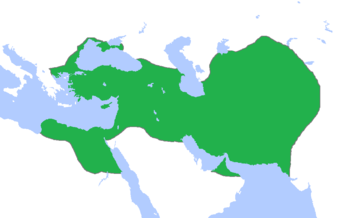
Achaemenid Empire Map
The Achaemenid Empire at its greatest extent.
The Ionian Revolt
In 499 BCE, Greeks in the region rose up against Persian rule in the Ionian Revolt.
At the heart of the rebellion lay a deep dissatisfaction
with the tyrants who were appointed by the Persians to rule the local Greek
communities. Specifically, the riot was incited by the Milesian tyrant
Aristagoras, who in the wake of a failed expedition to conquer Naxos, utilized
Greek unrest against Persian king Darius the Great to his own political
purposes.
Athens and other Greek cities sent aid, but were quickly forced to back down after defeat in 494 BCE, at the Battle of Lade. As a result, Asia Minor returned to Persian control.
Nonetheless, the Ionian Revolt remains
significant as the first major conflict between Greece and the Persian Empire, as well as the first phase of the Persian Wars. Darius vowed to exact revenge
against Athens, and developed a plan to conquer all Greeks in an attempt to
secure the stability of his empire.
First Persian Invasion of Greece
In 492 BCE, the Persian general, Mardonius, led a campaign through Thrace and Macedonia.
During this campaign, Mardonius re-subjugated Thrace and forced Macedonia
to become a fully submissive client of the Persian Empire, whereas before they
had maintained a broad degree of autonomy.
While victorious, he was wounded and forced to retreat back into Asia Minor. Additionally, he lost his 1200-ship naval fleet to a storm off the coast of Mount Athos.
Darius sent ambassadors to all Greek cities to demand full submission in
light of the recent Persian victory, and all cities submitted, with the
exceptions of Athens and Sparta, both of which executed their respective
ambassadors. These actions signaled Athens’ continued defiance and brought
Sparta into the conflict.
In 490 BCE, approximately 100,000 Persians landed in Attica intending to conquer Athens, but were defeated at the Battle of Marathon by a Greek army of 9,000 Athenian hoplites and 1,000 Plateans, led by the Athenian general, Miltiades. The Persian fleet continued to sail to Athens but, seeing it garrisoned, decided not to attempt an assault.
The Battle of Marathon was a watershed moment in the Persian Wars, in
that it demonstrated to the Greeks that the Persians could be defeated. It also
demonstrated the superiority of the more heavily armed Greek hoplites.
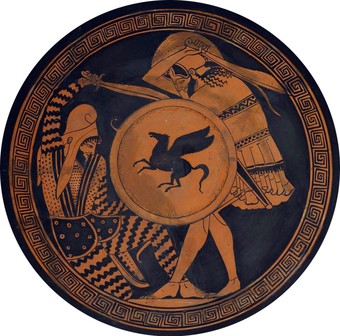
Greek-Persian duel
Depiction of a Greek hoplite and a Persian warrior fighting each other on an ancient kylix.
Interbellum (490-480 BCE)
After the failure of the first Persian invasion, Darius
raised a large army with the intent of invading Greece again. However, in 486
BCE, Darius’s Egyptian subjects revolted, postponing any advancement against
Greece. During preparations to march on Egypt, Darius died and his son, Xerxes
I, inherited the throne. Xerxes quickly crushed the Egyptians and resumed
preparations to invade Greece.
Second Invasion of
Greece
In 480 BCE, Xerxes sent a much more powerful force of 300,000 soldiers by land, with 1,207 ships in support, across a double pontoon bridge over the Hellespont. This army took Thrace before descending on Thessaly and Boetia, whilst the Persian navy skirted the coast and resupplied the ground troops. The Greek fleet, meanwhile, dashed to block Cape Artemision. After being delayed by Leonidas I, the Spartan king of the Agiad Dynasty, at the Battle of Thermopylae (a battle made famous due to the sheer imbalance of forces, with 300 Spartans facing the entire Persian Army), Xerxes advanced into Attica, where he captured and burned Athens. But the Athenians had evacuated the city by sea, and under the command of Themistocles, defeated the Persian fleet at the Battle of Salamis.
In 483 BCE, during the period of peace between the two Persian invasions, a vein of silver ore had been discovered in the Laurion (a small mountain range near Athens), and the ore that was mined there paid for the construction of 200 warships to combat Aeginetan piracy. A year later, the Greeks, under the Spartan Pausanias, defeated the Persian army at Plataea. Meanwhile, the allied Greek navy won a decisive victory at the Battle of
Mycale, destroying the Persian fleet, crippling Xerxe’s sea power, and marking
the ascendency of the Greek fleet. Following the Battle of Plataea and the Battle of Mycale, the Persians began withdrawing from Greece and never attempted an invasion again.
Greek Counterattack
The
Battle
of Mycale was in many ways a turning point, after which the Greeks went on the
offensive against the Persian fleet. The Athenian fleet turned to chasing the Persians from the Aegean Sea, and in 478 BCE, the fleet then proceeded to capture Byzantium. In the course of doing so, Athens enrolled all the island states, and some mainland states, into an alliance called the Delian League—
so named because its treasury was kept on the sacred island of Delos,
whose
purpose was to continue fighting the Persian Empire, prepare for future
invasions, and organize a means of dividing the spoils of war. The Spartans, although they had taken part in the war, withdrew into isolation afterwards.
The
Spartans believed that the war’s purpose had already been reached through the
liberation of mainland Greece and the Greek cities of Asia Minor. Historians
also speculate that Sparta was unconvinced of the ability of the Delian League
to secure long-term security for Asian Greeks. The Spartan withdrawal from the
League allowed Athens to establish unchallenged naval and commercial power within the Hellenic world.
7.3.2: Effects of the Persian Wars
Despite their victories in the Persian Wars, the Greek
city-states emerged from the conflict more divided than united.
Learning Objective
Understand the effect the Persian Wars had on the balance of power throughout the classical world
Key Points
- After the second Persian invasion of Greece was
halted, Sparta withdrew from the Delian League and reformed the Peloponnesian
League with its original allies. - Many Greek city-states had been alienated from
Sparta following the violent actions of Spartan leader Pausanias during the
siege of Byzantium. - Following Sparta’s departure from the Delian
League, Athens was able to use the resources of the League to its own ends,
which led it into conflict with less powerful members of the League. - The Persian Empire adopted a divide-and-rule
strategy in relation to the Greek city-states in the wake of the Persian Wars,
stoking already simmering conflicts, including the rivalry between Athens and
Sparta, to protect the Persian Empire against further Greek attacks.
Key Terms
- Peloponnesian League
-
An alliance formed around Sparta in the Peloponnesus, from the 6th to 4th centuries BCE.
- Delian League
-
An association
of Greek city-states under the leadership of Athens, the purpose of which was to continue
fighting the Persian Empire after the Greek victories at the end of the Second
Persian invasion of Greece. - hegemony
-
The
political, economic, or military predominance or control of one state over
others.
Aftermath of the Persian Wars
As a result of the allied Greek success, a large contingent
of the Persian fleet was destroyed and all Persian garrisons were expelled from
Europe, marking an end of Persia’s advance westward into the continent. The
cities of Ionia were also liberated from Persian control. Despite their
successes, however, the spoils of war caused greater inner conflict within the
Hellenic world. The violent actions of Spartan leader Pausanias at the siege of
Byzantium, for instance, alienated many of the Greek states from Sparta, and led
to a shift in the military command of the Delian League from Sparta to Athens. This set the stage for Sparta’s eventual withdrawal from the Delian League.
Two Leagues
Following the two Persian invasions of Greece, and during
the Greek counterattacks that commenced after the Battles of Plataea and
Mycale, Athens enrolled all island and some mainland city-states into an
alliance, called the Delian League, the purpose of which was to pursue conflict
with the Persian Empire, prepare for future invasions, and organize a means of
dividing the spoils of war. The Spartans, although they had taken part in the
war, withdrew from the Delian League early on, believing that the war’s initial
purpose had been met with the liberation of mainland Greece and the Greek
cities of Asia Minor. Historians also speculate that Sparta decided to leave the
League for pragmatic reasons, remaining unconvinced that it was possible to
secure long-term security for Greeks residing in Asia Minor, and as a result of
their unease with Athenian efforts to increase their power. Once Sparta
withdrew from the Delian League after the Persian Wars, it reformed the
Peloponnesian League, which had originally been formed in the 6th
century and provided the blueprint for what was now the Delian League. The
Spartan withdrawal from the League had the effect, however, of allowing Athens
to establish unchallenged naval and commercial power, unrivaled throughout the
Hellenic world. In fact, shortly after the League’s inception, Athens began to
use the League’s navy for its own purposes, which frequently led it into
conflict with other, less powerful League members.
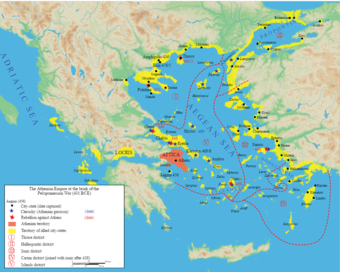
Map of the Athenian Empire c. 431 BCE
The Delian League was the basis for the Athenian Empire, shown here on the brink of the Peloponnesian War (c. 431 BCE).
Delian League Rebellions
A series of rebellions occurred between Athens and the
smaller city-states that were members of the League. For example, Naxos was the
first member of the League to attempt to secede, in approximately 471 BCE. It
was later defeated and forced to tear down its defensive city walls, surrender
its fleet, and lost voting privileges in the League. Thasos, another League
member, also defected when, in 465 BCE, Athens founded the colony of Amphipolis
on the Strymon River, which threatened Thasos’ interests in the mines of Mt
Pangaion. Thasos allied with Persia and petitioned Sparta for assistance, but
Sparta was unable to help because it was facing the largest helot revolution in
its history. Nonetheless, relations between Athens and Sparta were soured by
the situation. After a three-year long siege, Thasos was recaptured and forced
back into the Delian League, though it also lost its defensive walls and fleet,
its mines were turned over to Athens, and the city-state was forced to pay
yearly tribute and fines. According to Thucydides, the siege of Thasos marked
the transformation of the League from an alliance into a hegemony.
Persia
Following their defeats at the hands of the
Greeks, and plagued by internal rebellions that hindered their ability to fight
foreign enemies, the Persians adopted a policy of divide-and-rule. Beginning in
449 BCE, the Persians attempted to aggravate the growing tensions between Athens
and Sparta, and would even bribe politicians to achieve these aims. Their
strategy was to keep the Greeks distracted with in-fighting, so as to stop the
tide of counterattacks reaching the Persian Empire. Their strategy was largely
successful, and there was no open conflict between the Greeks and Persia until
396 BCE, when the Spartan king Agesilaus briefly invaded Asia Minor.
7.4: Athens
7.4.1: Athens
Athens attained its Golden Age under Pericles in the 5th century BCE, and flourished culturally as the hegemonic power of the Hellenic world.
Learning Objective
Understand the factors contributing to the rise and fall of Athens
Key Points
- Cleisthenes overthrew the dictator Hippias in 511/510 BCE in order to establish democracy at Athens.
- Athens entered its Golden Age in the 5th century BCE, when it abandoned the pretense of parity and relocated the treasury of the Delian League from Delos to Athens. This money funded the building of the Athenian Acropolis, put half the Athenian population on the public payroll, and allowed Athens to build and maintain the dominant naval power in the Greek world.
- With the empire’s funds, military dominance, and its political fortunes as guided by statesman and orator Pericles, Athens produced some of the most influential and enduring cultural artifacts of the Western tradition.
- Tensions within the Delian League brought about the Peloponnesian War (431-404 BCE), during which Athens was defeated by its rival, Sparta. Athens lost further power when the armies of Philip II defeated an alliance of Greek city-states.
Key Terms
- Acropolis
-
A settlement, especially a citadel, built upon an area of elevated ground, frequently a hill with precipitous sides, chosen for purposes of defense. Often the nuclei of large cities of classical antiquity.
- Pericles
-
A prominent and influential Greek statesman, orator, and general of Athens during its Golden Age, in the time between the Persian and Peloponnesian wars.
- Delian League
-
Founded in 478 BCE, an association of Greek city-states under the leadership of Athens, whose purpose was to fight the Persian Empire during the Greco-Persian Wars.
The Rise of Athens (508-448 BCE)
In 514 BCE, the dictator Hippias established stability and prosperity with his rule of Athens, but remained very unpopular as a ruler. With the help of an army from Sparta in 511/510 BCE, he was overthrown by Cleisthenes, a radical politician of aristocratic background who established democracy in Athens.
Prior to the rise of Athens, Sparta, a city-state with a militaristic culture, considered itself the leader of the Greeks, and enforced an hegemony. In 499 BCE, Athens sent troops to aid the Ionian Greeks of Asia Minor, who were rebelling against the Persian Empire during the Ionian Revolt. This provoked two Persian invasions of Greece, both of which were repelled under the leadership of the soldier-statesmen Miltiades and Themistocles, during the Persian Wars. In the decades that followed, the Athenians, with the help of the Spartans and other allied Greek city-states, managed to rout the Persians. These victories enabled Athens to bring most of the Aegean, and many other parts of Greece, together in the Delian League, creating an Athenian-dominated alliance from which Sparta and its allies withdrew.
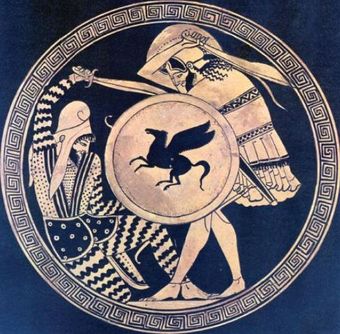
Greek-Persian Duel
Athenian Hegemony and the Age of Pericles
The 5th century BCE was a period of Athenian political hegemony, economic growth, and cultural flourishing that is sometimes referred to as the Golden Age of Athens. The latter part of this time period is often called The Age of Pericles. After peace was made with Persia in the 5th century BCE, what started as an alliance of independent city-states became an Athenian empire. Athens moved to abandon the pretense of parity among its allies, and relocated the Delian League treasury from Delos to Athens, where it funded the building of the Athenian Acropolis, put half its population on the public payroll, and maintained the dominant naval power in the Greek world. With the empire’s funds, military dominance, and its political fortunes as guided by statesman and orator Pericles, Athens produced some of the most influential and enduring cultural artifacts of Western tradition, during what became known as the Golden Age of Athenian democracy, or the Age of Pericles. The playwrights Aeschylus, Sophocles, and Euripides all lived and worked in Athens during this time, as did historians Herodotus and Thucydides, the physician Hippocrates, and the philosopher Socrates.
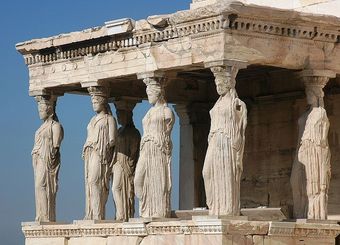
Caryatid Statues
The caryatid statues of the Erechtheion on the Acropolis.
Pericles was
arguably the most prominent and influential Greek statesman, orator, and
general of Athens during its Golden Age.
One of his most popular reforms while in power was to allow thetes (Athenians without wealth) to occupy public office. Another success of his administration was the creation of the misthophoria, a special salary for the citizens that attended the courts as jurors. As Athens’ ruler, he helped the city to prosper with a resplendent culture and democratic institutions.
5th century Athenian
Political Institutions
The administration of
the Athenian state was managed by a group of people referred to as magistrates, who were submitted to rigorous public control and chosen by lot. Only two
magistrates were directly elected by the Popular Assembly: strategos (or generals), and magistrates of finance. All magistrates
served for a year or less, with the exception of Pericles, who was elected year
after year to public office. At the end of their service, magistrates were required
to give an account of their administration and use of public finances.
The most elite posts in
the Athenian political system belonged to archons. In ages past, they served as
heads of the Athenian state, but in the Age of Pericles they lost much of their
influence and power, though they still presided over tribunals. The Assembly of
the People was the first organ of democracy in Athens. In theory, it was
composed of all the citizens of Athens. However, it is estimated that the
maximum number of participants it witnessed was 6,000. The Assembly met in
front of the Acropolis and decided on laws and decrees. Once the Assembly gave
its decision in a certain matter, the issue was raised to the Council, or Boule, to provide definitive approval.
The Council consisted of
500 members, 50 from each tribe, and functioned as an extension of the
Assembly. Council members were chosen by lot in a similar manner to magistrates
and supervised the work of the magistrates in addition to other legal projects
and administrative details. They also oversaw the city-state’s external
affairs.
Athenian Defeat and Conquest By Macedon
Originally intended as an association of Greek city-states to continue the fight against the Persians, the Delian League soon turned into a vehicle for Athens’s own imperial ambitions and empire-building. The resulting tensions brought about the Peloponnesian War (431-404 BCE), in which Athens was defeated by its rival, Sparta. By the mid-4th century BCE, the northern Greek kingdom of Macedon was becoming dominant in Athenian affairs. In 338 BCE, the armies of Philip II of Macedon defeated an alliance of some of the Greek city-states, including Athens and Thebes, at the Battle of Chaeronea, effectively ending Athenian independence.
7.4.2: Athenian Society
Classical Athenian society was structured as a democratic
patriarchy that strived towards egalitarian ideals.
Learning Objective
Understand the structures of Athenian society in the classical period
Key Points
- The citizens of Athens decided matters of state
in the Assembly of the People, the principle organ of Athen’s democracy. - The Athenian democracy provided a number of
governmental resources to its population in order to encourage participation in the
democratic process. - Many governmental posts in classical Athens were
chosen by lot, in an attempt to discourage corruption and patronage. - The Athenian elite lived relatively modestly, and
wealth and land were not concentrated in the hands of the few, but rather
distributed fairly evenly across the upper classes. - Thetes occupied the lowest rung of Athenian
society, but were granted the right to hold public office during the reforms of
Ephialtes and Pericles. - Athenian society was a patriarchy; men held
all rights and advantages, such as access to education and power. - Athenian women were dedicated to the care and
upkeep of the family home.
Key Terms
- thetes
-
The
lowest social class of citizens in ancient Athens. - Assembly of the People
-
The
democratic congregation of classical Athens, which, in theory, brought together
all citizens to decide upon proposed laws and decrees.
Structure of the Athenian Government
In the Assembly of the People, Athenian citizens decided
matters of state. In theory, it was composed of all the citizens of Athens; however, it is estimated that the maximum number of participants it included
was 6,000. Since many citizens were incapable of exercising political rights, due to their poverty or ignorance, a number of governmental resources existed
to encourage inclusivity. For example, the Athenian democracy provided the
following to its population:
- Concession of salaries to public functionaries
-
Help finding work for the poor
-
Land grants for dispossessed villagers
-
Public assistance for war widows, invalids,
orphans, and indigents
In order to discourage corruption and patronage, most public
offices that did not require specialized expertise were appointed by lot rather
than by election. Offices were also rotated so that members could serve in all
capacities in turn, in order to ensure that political functions were instituted
as smoothly as possible regardless of each individual official’s capacity.
When the Assembly of the People reached decisions on laws and
decrees, the issue was raised to a body called the Council, or Boule, to provide definitive approval.
The Council consisted of 500 members, 50 from each tribe, and functioned as an
extension of the Assembly. Council members, who were chosen by lot, supervised
the work of other government officials, legal projects, and other
administrative details. They also oversaw the city-state’s external affairs.
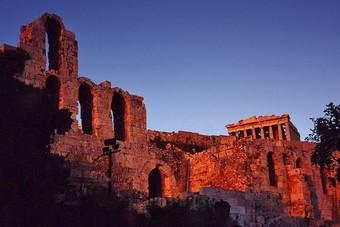
The Acropolis
View of the Acropolis in Athens, Greece.
Athenians in the Age of Pericles
The Athenian elite lived modestly and without great luxuries
compared to the elites of other ancient societies. Wealth and land ownership
was not typically concentrated in the hands of a few people. In fact, 71-73% of
the citizen population owned 60-65% of the land. By contrast, thetes occupied the lowest social class
of citizens in Athens. Thetes worked
for wages or had less than 200 medimnoi
as yearly income. Many held crucial roles in the Athenian navy as rowers, due to
the preference of many ancient navies to rely on free men to row their galleys.
During the reforms of Ephialtes and Pericles around 460-450 BCE, thetes were granted the right to hold
public office.
Boys were educated at home until the age of seven, at which
time they began formal schooling. Subjects included reading, writing,
mathematics, and music, as well as physical education classes that were intended
to prepare students for future military service. At the age of 18, service in
the army was compulsory.
Athenian women were dedicated to the care and
upkeep of the family home. Athenian society was a patriarchy; men held all
rights and advantages, such as access to education and power. Nonetheless, some
women, known as hetaeras, did receive
an education with the specific purpose of entertaining men, similar to the
Japanese geisha tradition. Hetaeras were considered higher in status than other women, but lower in status than
men. One famous example of a hetaera is Pericles’ mistress, Aspasia of Miletus,
who is said to have debated with prominent writers and thinkers, including
Socrates.
7.5: Culture in Classical Greece
7.5.1: Classical Greek Philosophy
The three most famous Classical Greek philosophers are Socrates, Plato, and Aristotle.
Learning Objective
Understand the main philosophical beliefs of Socrates, Plato, and Aristotle
Key Points
- Socrates is best known for having pursued a probing question-and-answer style of examination on a number of topics, usually attempting to arrive at a defensible and attractive definition of a virtue.
- In 399 BCE, Socrates was charged for his philosophical inquiries, convicted, and sentenced to death.
- Plato was a student of Socrates, and is the author of numerous dialogues and letters, as well as one of the primary sources available to modern scholars on Socrates’ life.
- In his defining work, The Republic, Plato reaches the conclusion that a utopian city is likely impossible because philosophers would refuse to rule and the people would refuse to compel them to do so.
- Aristotle was a student of Plato, the tutor of Alexander the Great, and founder of the Lyceum and Peripatetic School of philosophy in Athens. He wrote on a number of subjects, including logic, physics, metaphysics, ethics, rhetoric, politics, and botany.
Key Terms
- allegory of the cave
-
A paradoxical analogy wherein Socrates argues that the invisible world is the most intelligible, and the visible world is the least knowable and obscure. Plato has Socrates describe a gathering of people who have lived chained to the wall of a cave all of their lives, facing a blank wall upon which shadows are projected. The shadows are as close as the prisoners get to viewing reality.
- Aristotle
-
The student of Plato, tutor to Alexander the Great, and founder of the Lyceum. A Greek philosopher who wrote on a number of topics, including logic, ethics, and metaphysics.
- aporia
-
In philosophy, a paradox or state of puzzlement; in rhetoric, a useful expression of doubt.
- Socrates
-
A classical Greek (Athenian) philosopher credited as one of the founders of Western philosophy. Known for a question-answer style of examination.
- Plato
-
The student of Socrates and author of The Republic. A philosopher and mathematician in classical Greece.
Classical Greece saw a flourishing of philosophers, especially in Athens during its Golden Age. Of these philosophers, the most famous are Socrates, Plato, and Aristotle.
Socrates
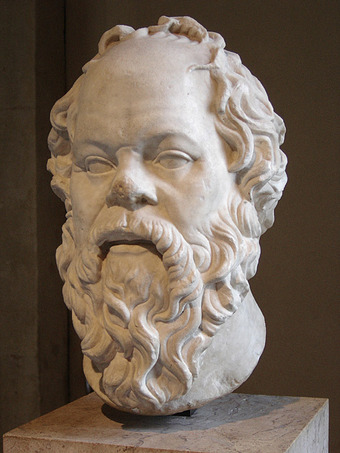
Socrates
Bust of Socrates, currently in the Louvre.
Socrates, born in Athens in the 5th century BCE, marks a watershed in ancient Greek philosophy. Athens was a center of learning, with sophists and philosophers traveling from across Greece to teach rhetoric, astronomy, cosmology, geometry, and the like. The great statesman Pericles was closely associated with these new teachings, however, and his political opponents struck at him by taking advantage of a conservative reaction against the philosophers. It became a crime to investigate issues above the heavens or below the earth because they were considered impious. While other philosophers, such as Anaxagoras, were forced to flee Athens, Socrates was the only documented individual charged under this law, convicted, and sentenced to death in 399 BCE. In the version of his defense speech presented by Plato, he claims that the envy others experience on account of his being a philosopher is what will lead to his conviction.
Many conversations involving Socrates (as recounted by Plato and Xenophon) end without having reached a firm conclusion, a style known as aporia. Socrates is said to have pursued this probing question-and-answer style of examination on a number of topics, usually attempting to arrive at a defensible and attractive definition of a virtue. While Socrates’ recorded conversations rarely provide a definitive answer to the question under examination, several maxims or paradoxes for which he has become known recur. Socrates taught that no one desires what is bad, and so if anyone does something that truly is bad, it must be unwillingly or out of ignorance; consequently, all virtue is knowledge. He frequently remarks on his own ignorance (claiming that he does not know what courage is, for example). Plato presents Socrates as distinguishing himself from the common run of mankind by the fact that, while they know nothing noble and good, they do not know that they do not know, whereas Socrates knows and acknowledges that he knows nothing noble and good.
Socrates was morally, intellectually, and politically at odds with many of his fellow Athenians. When he was on trial, he used his method of elenchos, a dialectic method of inquiry that resembles
the scientific method, to demonstrate to the jurors that their moral values are wrong-headed. He tells them they are concerned with their families, careers, and political responsibilities when they ought to be worried about the “welfare of their souls.” Socrates’ assertion that the gods had singled him out as a divine emissary seemed to provoke irritation, if not outright ridicule. Socrates also questioned the Sophistic doctrine that arete (virtue) can be taught. He liked to observe that successful fathers (such as the prominent military general Pericles) did not produce sons of their own quality. Socrates argued that moral excellence was more a matter of divine bequest than parental nurture.
Plato
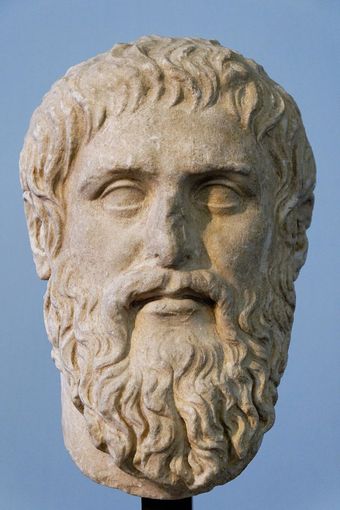
Plato
A copy of Plato’s portrait bust by Silanion.
Plato was an Athenian of the generation after Socrates. Ancient tradition ascribes 36 dialogues and 13 letters to him, although of these only 24 of the dialogues are now universally recognized as authentic. Most modern scholars believe that at least 28 dialogues, and two of the letters, were in fact written by Plato, although all of the 36 dialogues have some defenders. Plato’s dialogues feature Socrates, although not always as the leader of the conversation. Along with Xenophon, Plato is the primary source of information about Socrates’ life and beliefs, and it is not always easy to distinguish between the two.
Much of what is known about Plato’s doctrines is derived from what Aristotle reports about them, and many of Plato’s political doctrines are derived from Aristotle’s works, The Republic, the Laws, and the Statesman. The Republic contains the suggestion that there will not be justice in cities unless they are ruled by philosopher kings; those responsible for enforcing the laws are compelled to hold their women, children, and property in common; and the individual is taught to pursue the common good through noble lies. The Republic determines that such a city is likely impossible, however, and generally assumes that philosophers would refuse to rule if the citizenry asked them to, and moreover, the citizenry would refuse to compel philosophers to rule in the first place.
“Platonism” is a term coined by scholars to refer to the intellectual consequences of denying, as Plato’s Socrates often does, the reality of the material world. In several dialogues, most notably The Republic, Socrates inverts the common man’s intuition about what is knowable and what is real. While most people take the objects of their senses to be real if anything is, Socrates is contemptuous of people who think that something has to be graspable in the hands to be real. Socrates’s idea that reality is unavailable to those who use their senses is what puts him at odds with the common man and with common sense. Socrates says that he who sees with his eyes is blind, and this idea is most famously captured in his allegory of the cave, a paradoxical analogy wherein Socrates argues that the invisible world is the most intelligible and that the visible world is the least knowable and most obscure.
In the allegory,
Socrates describes a gathering of people who have lived chained to the wall of
a cave facing a blank wall. The people watch shadows projected on the wall from
the fire burning behind them, and the people begin to name and describe the
shadows, which are the closest images they have to reality. Socrates then
explains that a philosopher is like a prisoner released from that cave who
comes to understand the shadows on the wall are not reality.
Aristotle
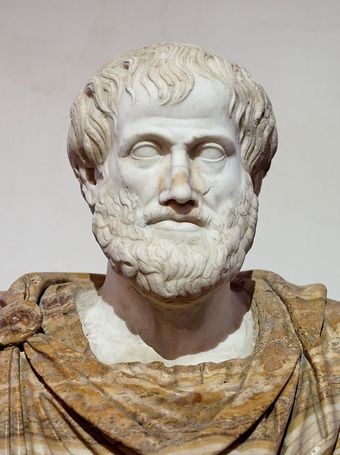
Aristotle
Roman copy in marble of a Greek bronze bust of Aristotle by Lysippus, c. 330 BCE. The alabaster mantle is modern.
Aristotle moved to Athens from his native Stageira in 367 BCE, and began to study philosophy, and perhaps even rhetoric, under Isocrates. He eventually enrolled at Plato’s Academy. He left Athens approximately twenty years later to study botany and zoology, became a tutor of Alexander the Great, and ultimately returned to Athens a decade later to establish his own school, the Lyceum.
He is the founder of the Peripatetic School of philosophy, which aims to
glean facts from experiences and explore the “why” in all things. In other
words, he advocates learning by induction.
At least 29 of Aristotle’s treatises have survived, known as the corpus Aristotelicum, and address a variety of subjects including logic, physics, optics, metaphysics, ethics, rhetoric, politics, poetry, botany, and zoology. Aristotle is often portrayed as disagreeing with his teacher, Plato. He criticizes the regimes described in Plato’s Republic and Laws, and refers to the theory of forms as “empty words and poetic metaphors.” He preferred utilizing empirical observation and practical concerns in his works.
Aristotle did not consider virtue to be simple knowledge as Plato did,
but founded in one’s nature, habit, and reason. Virtue was gained by acting in
accordance with nature and moderation.
7.5.2: Classical Greek Poetry and History
Homer, one of the greatest Greek poets, significantly influenced
classical Greek historians as their field turned increasingly towards scientific
evidence-gathering and analysis of cause and effect.
Learning Objective
Explain how epic poetry influenced the development of classical Greek historical texts
Key Points
- The formative influence of the Homeric epics in shaping Greek culture was widely recognized, and Homer was described as the teacher of Greece.
- The Iliad, sometimes referred to as the Song of Ilion or Song of Ilium, is set during the Trojan War and recounts the battles and events surrounding a quarrel between King Agamemnon and the warrior Achilles.
-
Herodotus is referred to as “The Father of History,” and is
the first historian known to have broken from Homeric tradition in order to
treat historical subjects as a method of investigation arranged into a
historiographic narrative. - Thucydides, who had been trained in rhetoric, provided a
model of historical prose-writing based more firmly in factual progression of a
narrative, whereas Herodotus, due to frequent digressions and asides, appeared
to minimize his authorial control. - Thucydides is sometimes known as the father of “scientific
history,” or an early precursor to 20th century scientific
positivism, because of his strict adherence to evidence-gathering and analysis
of historical cause and effect without reference to divine intervention. - Despite its heavy
political slant, scholars cite strong literary and philosophical influences in
Thucydides’ work.
Key Terms
- Homer
-
A Greek poet of the 7th or 8th century BCE; author of the Iliad and the Odyssey.
- dactylic hexameter
-
A form of meter in poetry or a rhythmic scheme. Traditionally associated with the quantitative meter of classical epic poetry in both Greek and Latin, and consequently considered to be the grand style of classical poetry.
Homer
In the Western classical tradition, Homer is the author of the Iliad and the Odyssey, and is revered as the greatest of ancient Greek epic poets. These epics lie at the beginning of the Western canon of literature, and have had an enormous influence on the history of literature.
Whether and when Homer lived is unknown. The ancient Greek author Herodotus estimates that Homer lived 400 years before his own time, which would place him at around 850 BCE, while other ancient sources claim that he lived much nearer to the supposed time of the Trojan War, in the early 12th century BCE. Most modern researchers place Homer in the 7th or 8th centuries BCE.
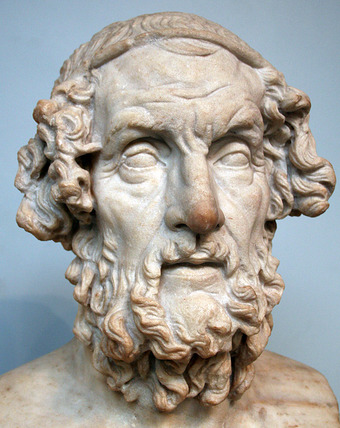
Homer
Idealized portrayal of Homer dating to the Hellenistic period; located at the British Museum.
The formative influence of the Homeric epics in shaping Greek culture was widely recognized, and Homer was described as the “Teacher of Greece.” Homer’s works, some 50% of which are speeches, provided models in persuasive speaking and writing that were emulated throughout the ancient and medieval Greek worlds. Fragments of Homer account for nearly half of all identifiable Greek literary papyrus finds.
The Iliad
The Iliad (sometimes referred to as the Song of Ilion or Song of Ilium) is an ancient Greek epic poem in dactylic hexameter. Set during the Trojan War (the ten-year siege of the city of Troy (Ilium) by a coalition of Greek states), it tells of the battles and events surrounding a quarrel between King Agamemnon and the warrior Achilles. Although the story covers only a few weeks in the final year of the war, the Iliad mentions or alludes to many of the Greek legends about the siege. The epic narrative describes events prophesied for the future, such as Achilles’ looming death and the sack of Troy. The events are prefigured and alluded to more and more vividly, so that when the story reaches an end, the poem has told a more or less complete tale of the Trojan War.
Nineteenth
century excavations at Hisarlik provided scholars with historical evidence for
the events of the Trojan War, as told by Homer in the Iliad. Additionally, linguistic studies into oral epic traditions
in nearby civilizations, and the deciphering of Linear B in the 1950s, provided
further evidence that the Homeric poems could have been derived from oral
transmissions of long-form tales about a war that actually took place. The
likely historicity of the Iliad as a
piece of literature, however, must be balanced against the creative license
that would have been taken over years of transmission, as well as the alteration of historical fact to conform with tribal preferences and provide entertainment
value to its intended audiences.
Herodotus
Herodotus was a Greek historian who was born in
Halicarnassus (modern-day Bodrum, Turkey) and lived in the 5th century BCE. He
was a contemporary of Socrates. He is referred to as “The Father of History” and is the first historian known to have broken from Homeric tradition in order
to treat historical subjects as a method of investigation arranged into a
historiographic narrative. His only known work is a history on the origins of
the Greco-Persian Wars, entitled, The
Histories. Herodotus states that he only reports that which was told to
him, and some of his stories are fanciful and/or inaccurate; however, the
majority of his information appears to be accurate.
Athenian tragic poets and storytellers appear to
have provided heavy inspiration for Herodotus, as did Homer. Herodotus appears
to have drawn on an Ionian tradition of storytelling, collecting and
interpreting oral histories he happened upon during his travels in much the
same way that oral poetry formed the basis for much of Homer’s works. While
these oral histories often contained folk-tale motifs and fed into a central
moral, they also related verifiable facts relating to geography, anthropology,
and history. For this reason, Herodotus drew criticism from his contemporaries,
being touted as a mere storyteller and even a falsifier of information. In
contrast to this type of approach, Thucydides, who had been trained in
rhetoric, provided a model of historical prose-writing based more firmly in
factual progression of a narrative, whereas Herodotus, due to frequent
digressions and asides, appeared to minimize his authorial control.
Thucydides
Thucydides was an Athenian historian and general.
His History of the Peloponnesian War
recounts the 5th century BCE war between Athens and Sparta. Thucydides
is sometimes known as the father of “scientific history,” or an early precursor
to 20th century scientific positivism, because of his strict
adherence to evidence-gathering and analysis of historical cause and effect
without reference to divine intervention. He is also considered the father of
political realism, which is a school of thought within the realm of political
science that views the political behavior of individuals and the relations
between states to be governed by self-interest and fear. More generally,
Thucydides’ texts show concern with understanding why individuals react the way
they do during such crises as plague, massacres, and civil war.
Unlike Herodotus, Thucydides did not view his
historical accounts as a source of moral lessons, but rather as a factual
reporting of contemporary political and military events. Thucydides viewed life
in political terms rather than moral terms, and viewed history in political terms. Thucydides also tended to omit, or at least downplay, geographic and
ethnographic aspects of events from his work, whereas Herodotus recorded all
information as part of the narrative. Thucydides’ accounts are
generally held to be more unambiguous and reliable than those of Herodotus. However, unlike his predecessor, Thucydides does not reveal his sources. Curiously,
although subsequent Greek historians, such as Plutarch, held up Thucydides’
writings as a model for scholars of their field, many of them continued to view
history as a source of moral lessons, as did Herodotus.
Despite its heavy
political slant, scholars cite strong literary and philosophical influences in
Thucydides’ work. In particular, the History
of the Peloponnesian War echoes the narrative tradition of Homer, and draws
heavily from epic poetry and tragedy to construct what is essentially a
positivistic account of world events. Additionally, it brings to the forefront themes
of justice and suffering in a similar manner to the philosophical texts of
Aristotle and Plato.
7.5.3: Classical Greek Theater
Classical Greek theater, whether tragic or comic, has
had great influence on modern literature and drama.
Learning Objective
Describe the common themes found in classical Greek plays
Key Points
-
The city-state of Athens was the center of
cultural power during this period, and held a drama festival in honor of the god
Dionysus, called the Dionysia. - Two dramatic genres to emerge from this era of
Greek theater were tragedy and comedy, both of which rose to prominence around
500-490 BCE. - Greek tragedy is an extension of the ancient
rites carried out in honor of Dionysus; it heavily influenced the theater of ancient
Rome and the Renaissance. - Tragic plots were often based upon myths from
the oral traditions of archaic epics, and took the form of narratives presented
by actors. - Aeschylus was the first tragedian to codify the
basic rules of tragic drama, and is considered by many to be the “father of
tragedy.” - Athenian comedy is divided into three periods:
Old Comedy, Middle Comedy, and New Comedy.
Key Terms
- chorus
-
In
the context of Greek theatre, a homogeneous, non-individualized group of
performers who comment, with a collective voice, on dramatic action. - deus ex machina
-
A plot
device whereby a seemingly unsolvable problem is suddenly and abruptly resolved
by the unexpected intervention of some new event, character, ability, or
object. - monody
-
In
the context of ancient Greek theater and literature, lyric poetry sung by a
single performer rather than by a chorus.
The theatrical culture of ancient Greece flourished from
approximately 700 BCE onward. The city-state of Athens was the center of
cultural power during this period and held a drama festival in honor of the god
Dionysus, called the Dionysia. This festival was exported to many of Athen’s
numerous colonies to promote a common cultural identity across the empire. Two dramatic
genres to emerge from this era of Greek theater were tragedy and comedy, both
of which rose to prominence around 500-490 BCE.
Greek Tragedy
Sometimes referred to as Attic tragedy, Greek tragedy is an
extension of the ancient rites carried out in honor of Dionysus, and it heavily
influenced the theater of ancient Rome and the Renaissance. Tragic plots were
often based upon myths from the oral traditions of archaic epics, and took the
form of narratives presented by actors. Tragedies typically began with a
prologue, in which one or more characters introduce the plot and explain the
background to the ensuing story. The prologue is then followed by paraodos, after which the story unfolds
through three or more episodes. The episodes are interspersed by stasima, or choral interludes that
explain or comment on the situation that is developing. The tragedy then ends
with an exodus, which concludes the
story.
Aeschylus and the Codification of Tragic Drama
Aeschylus was the first tragedian to codify the basic rules
of tragic drama. He is often described as the father of tragedy. He is credited
with inventing the trilogy, a series of three tragedies that tell one long
story. Trilogies were often performed in sequence over the course of a day,
from sunrise to sunset. At the end of the last play, a satyr play was staged to
revive the spirits of the public after they had witnessed the heavy events of
the tragedy that had preceded it.
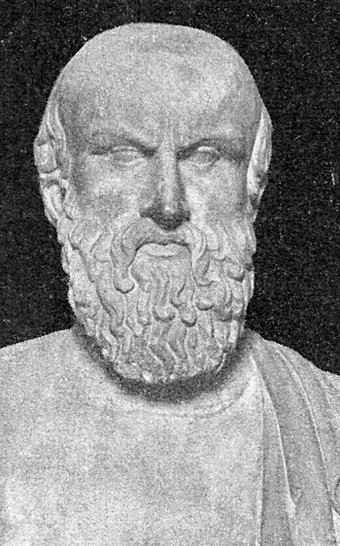
Marble bust of Aeschylus
According to Aristotle, Aeschylus also expanded the number
of actors in theater to allow for the dramatization of conflict on stage.
Previously, it was standard for only one character to be present and interact
with the homogeneous chorus, which commented in unison on the dramatic action
unfolding on stage. Aeschylus’s works show an evolution and enrichment in
dialogue, contrasts, and theatrical effects over time, due to the rich
competition that existed among playwrights of this era. Unfortunately, his
plays, and those of Sophocles and Euripides, are the only works of classical
Greek literature to have survived mostly intact, so there are not many rival
texts to examine his works against.
The Reforms of Sophocles
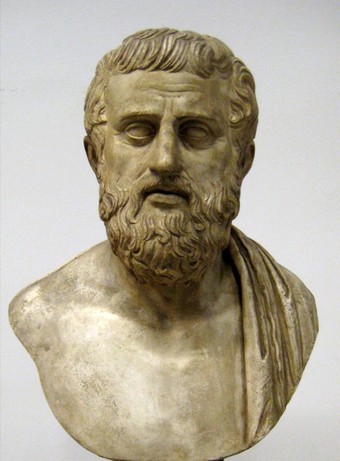
Cast of Sophocles’ bust in the Pushkin Museum
Sophocles was one such rival who triumphed against the
famous and previously unchallenged Aeschylus. Sophocles introduced a third
actor to staged tragedies, increased the chorus to 15 members, broke the cycle
of trilogies (making possible the production of independent dramas), and introduced
the concept of scenery to theater. Compared to the works of Aeschylus, choruses
in Sophocles’ plays did less explanatory work, shifting the focus to deeper
character development and staged conflict. The events that took place were often left unexplained or unjustified, forcing the audience to reflect upon the
human condition.
The Realism of Euripides
Euripides differs from Aeschylus and Sophocles in his search
for technical experimentation and increased focus on feelings as a mechanism to
elaborate the unfolding of tragic events. In Euripides’ tragedies, there are
three experimental aspects that reoccur. The first is the transition of the
prologue to a monologue performed by an actor informing spectators of a story’s
background. The second is the introduction of deus ex machina, or a plot device whereby a seemingly unsolvable
problem is suddenly and abruptly resolved by the unexpected intervention of
some new event, character, ability, or object. Finally, the use of a chorus was
minimized in favor of a monody sung by the characters.
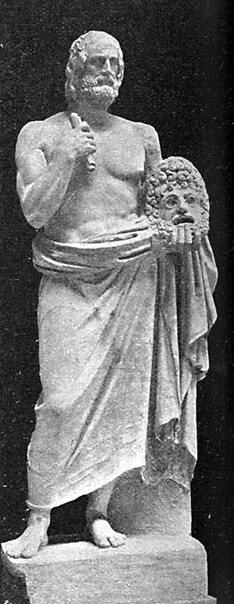
Statue of Euripides
Another novelty introduced by Euripidean drama is the
realism with which characters’ psychological dynamics are portrayed. Unlike in
Aeschylus or Sophocles’ works, heroes in Euripides’ plays were portrayed as
insecure characters troubled by internal conflict rather than simply resolute.
Female protagonists were also used to portray tormented sensitivity and
irrational impulses that collided with the world of reason.
Greek Comedy
As Aristotle wrote in his Poetics, comedy is defined by the representation of laughable
people, and involves some kind of blunder or ugliness that does not cause pain
or disaster. Athenian comedy is divided into three periods: Old Comedy, Middle
Comedy, and New Comedy. The Old Comedy period is largely represented by the 11
surviving plays of Aristophanes, whereas much of the work of the Middle Comedy
period has been lost. New Comedy is known primarily by the substantial papyrus
fragments of Menander. In general, the divisions between these periods is
largely arbitrary, and ancient Greek comedy almost certainly developed
constantly over the years.
Old Comedy and Aristophanes
Aristophanes, the most important Old Comic dramatist, wrote
plays that abounded with political satire, as well as sexual and scatological
innuendo. He lampooned the most important personalities and institutions of his
day, including Socrates in The Clouds.
His works are characterized as definitive to the genre of comedy even today.
Middle Comedy
Although the line between Old and Middle Comedy is not
clearly marked chronologically, there are some important thematic differences between
the two. For instance, the role of the chorus in Middle Comedy was
largely diminished to the point where it had no influence on the plot.
Additionally, public characters were no longer impersonated or personified
onstage, and objects of ridicule tended to be more general rather than
personal, and in many instances, literary rather than political. For some time,
mythological burlesque was popular among Middle Comic poets. Stock characters
also were employed during this period. In-depth assessment and critique of the
styling of Middle Comedy is difficult, given the lack of complete bodies of
work. However, given the revival of this style in Sicily and Magna Graecia, it
appears that the works of this period did have considerable widespread
literary and social impact.
New Comedy
The style of New Comedy is comparable to what is
contemporarily referred to as situation comedy or comedy of manners. The
playwrights of Greek New Comedy built upon the devices, characters, and
situations their predecessors had developed. Prologues to shape the audience’s
understanding of events, messengers’ speeches to announce offstage action, and ex machina endings were all well
established tropes that were used in New Comedies. Satire and farce occupied
less importance in the works of this time, and mythological themes and subjects
were replaced by everyday concerns. Gods and goddesses were, at best,
personified abstractions rather than actual characters, and no miracles or
metamorphoses occurred. For the first time, love became a principal element in
this type of theater.
Three playwrights are well known from this period: Menander,
Philemon, and Diphilus. Menander was the most successful of the New Comedians.
Menander’s comedies focused on the fears and foibles of the ordinary man, as
opposed to satirical accounts of political and public life, which perhaps lent
to his comparative success within the genre. His comedies are the first to
demonstrate the five-act structure later to become common in modern plays. Philemon’s
comedies dwell on philosophical issues, whereas Diphilus was noted for his use
of farcical violence.
7.5.4: Classical Greek Architecture
Classical Greek architecture can be divided into
three separate styles: the Doric Order, the Ionic Order, and the Corinthian
Order.
Learning Objective
Describe the distinguishing characteristics of Classical Greek Architecture
Key Points
- Classical Greek
architecture is best represented by substantially intact ruins of temples and
open-air theaters. - The
architectural style of classical Greece can be divided into three separate
orders: the Doric Order, the Ionic Order, and the Corinthian Order. All three
styles have had a profound impact on Western architecture of later periods. -
While the three
orders of Greek architecture are most easily recognizable by their capitals,
the orders also governed the form, proportions, details, and relationships of
the columns, entablature, pediment, and stylobate. - The Parthenon is considered the most important
surviving building of classical Greece, and the zenith of Doric Order
architecture.
Key Terms
- capitals
-
In architecture, a capital forms the topmost
member of a column. - entablature
-
An entablature is the superstructure of moldings
and bands that lay horizontally above columns and rest on capitals. - pediment
-
A pediment is an element in classical,
neoclassical, and baroque architecture that is placed above the horizontal
structure of an entablature, and is typically supported by columns. - stylobate
-
In classical Greek architecture, a stylobate is
the top step of a stepped platform upon which colonnades of temple columns are
placed. In other words, the stylobate comprises the temple flooring.
Classical Greek architecture
is highly formalized in structure and decoration, and is best known for its
temples, many of which are found throughout the region as substantially intact
ruins. Each classical Greek temple appears to have been conceived as a
sculptural entity within the landscape, and is usually raised on higher ground
so that its proportions and the effects of light on its surface can be viewed
from multiple angles. Open-air theaters are also an important type of building
that survives throughout the Hellenic world, with the earliest dating from
approximately 525-480 BCE.
Greek architectural style
can be divided into three separate orders: the Doric Order, the Ionic Order,
and the Corinthian Order. These styles have had a profound impact on Western
architecture of later periods. In particular, the architecture of ancient Rome
grew out of Greek architecture. Revivals of Classicism have also brought about renewed
interest in the architectural styles of ancient Greece. While the three orders
of Greek architecture are most easily recognizable by their capitals, the
orders also governed the form, proportions, details, and relationships of the
columns, entablature, pediment, and stylobate. Orders were applied to the whole
range of buildings and monuments.
The Doric Order
The Doric Order developed on mainland Greece and spread to
Italy. It is most easily recognized by its capital, which appears as a circular
cushion placed on top of a column onto which a lintel rests. In early examples
of the Doric Order, the cushion is splayed and flat, but over time, it became more
refined, deeper, and with a greater curve.
Doric columns almost always feature fluting down the
length of the column, numbering up to 20 flutes. The flutes meet at sharp edges, called
arrises. Doric columns typically have no bases, with the exception of a few
examples dating from the Hellenistic period. Columns of an early Doric temple, such as the Temple of Apollo at Syracuse, could have a column height to an entablature ratio of 2:1, and a column height to a base diameter ratio of only
4:1. Later, a column height to a diameter ratio of 6:1 became more usual, and there is a column height to an entablature ratio at the Parthenon oapproximately 3:1.
Doric entablatures consist of three parts: the architrave,
the frieze, and the cornice. The architrave is composed of stone lintels that
span the space between columns. On top of this rests the frieze, one of the
major areas of sculptural decoration. The frieze is divided into triglyps and
metopes. The triglyphs have three vertical grooves, similar to columnar
fluting, and below them are guttae, small strips that appear to connect the
triglyps to the architrave below. The triglyps are located above the center of
each capital and the center of each lintel.
Pediments in the Doric style were decorated with figures in
relief in early examples; however, by the time the sculptures on the Parthenon
were created, many pediment decorations were freestanding.
The Parthenon
The Parthenon is considered the most important surviving
building of classical Greece and the zenith of Doric Order architecture. It is
a former temple on the Athenian Acropolis dedicated to the patron goddess of
Athens, Athena. Construction began on the Parthenon in 447 BCE, when the
Athenian Empire was at its peak. Construction was completed in 438 BCE, but
decoration of the building continued until 432 BCE. Although most architectural
elements of the Parthenon belong to the Doric Order, a continuous sculptured
frieze in low relief that sits above the architrave belongs to the Ionic style.
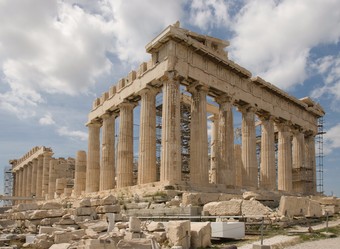
The Parthenon
The Parthenon under restoration in 2008.
The Ionic Order
The Ionic Order coexisted with the Doric Order and was
favored by Greek cities in Ionia, Asia Minor, and the Aegean Islands. It did
not evolve into a clearly defined style until the mid-5th century
BCE. Early Ionic temples in Asia Minor were particularly ambitious in scale.
The Ionic Order is most easily identified by its voluted
capital. The cushion placed on top of the column is similarly shaped to that of
the Doric Order, but is decorated with a stylized ornament and surmounted by a
horizontal band that scrolls under to either side.
Ionic Order columns are fluted with narrow, shallow flutes
that do not meet at a sharp edge, but have a flat band between them. The usual
number of flutes is 24, but there can be as many as 44. The architrave is
not always decorated, but more often it rises in three outwardly-stepped
bands. The frieze runs in a continuous band and is separated from other members
by rows of small projecting blocks.
The Ionic Order is lighter in appearance than the Doric
Order, with columns that have a 9:1 ratio, and the diameter and the whole
entablature appears much narrower and less heavy than those of the Doric.
Decorations were distributed with some variation, and Ionic entablatures often
featured formalized bands of motifs. The external frieze often contained a
continuous band of figurative sculpture of ornament, though this was not always
the case. Caryatids—draped female figures used as supporting members to the
entablature—were also a feature of the Ionic Order.
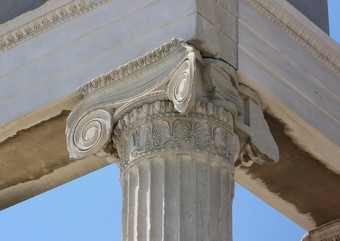
The Erechteum on the Acropolis of Athens, Greece
Corner capital in the Ionic style with a diagonal volute, showing also details of the fluting separated by fillets.
The Corinthian Order
The Corinthian Order grew directly from the Ionic in the
mid-5th century BCE, and was initially of a very similar style and
proportion, with the only distinguishing factor being its more ornate capitals.
The capitals of the Corinthian Order were much deeper than those of the Doric
and Ionic Orders. They were shaped like a bell-shaped mixing bowl and
ornamented with a double row of acanthus leaves above which rose splayed, voluted
tendrils. The ratio of column height to diameter of the Corinthian
Order is generally 10:1, with the capital taking up more than a tenth of the
height. The ratio of capital height to diameter is generally about 1:16:1.
Initially the Corinthian Order was used
internally in such sites as the Temple of Apollo Epicurius at Bassae. By the
late 300s, features of the Corinthian Order began to be used externally at
sites such as the Choragic Monument of Lysicrates and the Temple of Zeus
Olympia, both in Athens. During the Hellenistic period, Corinthian columns were
sometimes built without fluting. The Corinthian Order became popular among
the Romans, who added a number of refinements and decorative details.
7.5.5: Scientific Advancements in the Classical Period
The Hellenistic Period witnessed significant scientific advancements, due to the mixing of Greek and Asian culture and royal patronage.
Learning Objective
Describe the various scientific advancements made during the Hellenistic period
Key Points
- Great seats of learning rose during the Hellenistic Period, including those at Alexandria and Antioch.
- Scientific inquiries were often sponsored by royal patrons.
- The
discoveries of several Greek mathematicians, including Pythagoras and Euclid,
are still used in mathematical teaching today. Important developments include the
basic rules of geometry, the idea of a formal mathematical proof, and
discoveries in number theory, mathematical analysis, and applied mathematics. - The
Greeks also developed the field of astronomy, which they treated as a branch of
mathematics to a highly sophisticated level. - Hippocrates was a physician
of the classical period, and is considered one of the most outstanding figures
in the history of medicine. Most notably, he founded the Hippocratic school of
medicine, which revolutionized medicine in ancient Greece by establishing it as
a discipline distinct from other fields, and making medicine a profession.
Key Terms
- Hellenistic period
-
The period of ancient Greek and Mediterranean history between the death of Alexander the Great in 323 BCE and the emergence of the Roman Empire, as signified by the Battle of Actium in 31 BCE.
- Alexandria
-
An important seat of learning within the Hellenistic civilization and the capital of Hellenistic, Roman, and Byzantine Egypt for almost 1,000 years, until the Muslim conquest of Egypt in 641 CE.
Hellenistic Culture
Hellenistic culture produced seats of learning in Alexandria, Egypt and Antioch, Syria, along with Greek-speaking populations across several monarchies. Hellenistic science differed from Greek science in at least two ways. First, it benefited from the cross-fertilization of Greek ideas with those that had developed in the larger Hellenistic world. Secondly, to some extent, it was supported by royal patrons in the kingdoms founded by Alexander’s successors.
Especially important to Hellenistic science was the city of Alexandria in Egypt, which became a major center of scientific research in the 3rd century BCE. Two institutions established there during the reigns of Ptolemy I Soter (reigned 323-283 BCE) and Ptolemy II Philadelphus (reigned 281-246 BCE) were the Library and the Museum. Unlike Plato’s Academy and Aristotle’s Lyceum, these institutions were officially supported by the Ptolemies, although the extent of patronage could be precarious, depending on the policies of the current ruler.
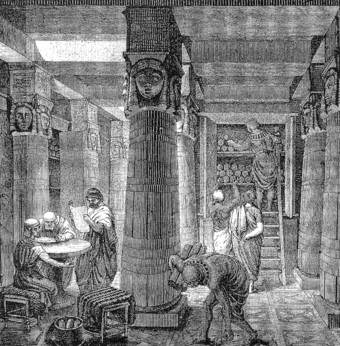
The Great Library of Alexandria
The Great Library of Alexandria, O. Von Corven. 19th century.
Mathematics and
Astronomy
The discoveries of
several Greek mathematicians, including Pythagoras and Euclid, are still used
in mathematical teaching today. Important developments include the basic rules
of geometry, the idea of a formal mathematical proof, and discoveries in number
theory, mathematical analysis, and applied mathematics. Ancient Greek
mathematicians also came close to establishing integral calculus.
The Greeks also
developed the field of astronomy, which they treated as a branch of
mathematics, to a highly sophisticated level. The first geometrical,
three-dimensional models to explain the apparent motion of the planets was developed
in the 4th century BCE, by Eudoxus of Cnidus and Callippus of
Cyzicus. Their younger contemporary, Heraclides Ponticus, proposed that the Earth
rotates around its axis. In the 3rd century BCE, Aristarchus of
Samos was the first to suggest a heliocentric system. In the 2nd
century BCE, Hipparchus of Nicea made a number of contributions, including the
first measurement of precession and the compilation of the first star catalog, in which he proposed the modern system of apparent magnitudes.
The Antikythera
mechanism, a device for calculating the movements of the planets, was the first
ancestor of the astronomical computer. It dates from about 80 BCE, and was
discovered in an ancient shipwreck off the Greek island of Antikythera. The
device became famous for its use of a differential gear, which was previously
believed to have been invented in the 16th century, as well as the
miniaturization and complexity of its parts, which has been compared to that of
clocks produced in the 18th century.
The Medical Field
The ancient Greeks also
made important discoveries in the medical field. Hippocrates was a physician of
the classical period, and is considered one of the most outstanding figures in
the history of medicine. He is sometimes even referred to as the “father of
medicine.” Most notably, he founded the Hippocratic school of medicine, which
revolutionized medicine in ancient Greece by establishing it as a discipline
distinct from other fields, and making medicine a profession.
Other notable Hellenistic scientists and their achievements include:
- Herophilos (335-280 BCE), who was the first to base medical conclusions on dissection of the human body and to describe the nervous system
- Archimedes (c. 287-212 BCE), a geometer, physicist, and engineer who laid the foundations of hydrostatics and statics, and explained the principle of the lever
- Eratosthenes (c. 276 BCE-195/194 BCE), who measured the distance between the Sun and the Earth, as well as the size of the Earth
7.6: The Peloponnesian War
7.6.1: Introduction to the Peloponnesian War
The
Peloponnesian War provided a dramatic end to the 5th century BCE, shattering
religious and cultural taboos, devastating vast swathes of countryside, and
destroying whole cities.
Learning Objective
Describe the events of the Peloponnesian War
Key Points
-
The Peloponnesian War (431-404 BCE) was fought
between Athens and its empire, known as the Delian League, and the
Peloponnesian League, led by Sparta. - During this conflict, Greek warfare evolved from
an originally limited and formalized form of conflict, to all-out struggles
between city-states, with large-scale atrocities. - During the first phase, known as the Archidamian
War, Sparta launched repeated invasions of Attica while Athens took advantage
of its naval supremacy to raid the Peloponnese coast. - Initially Athens’ strategy, as guided by
Pericles, was to avoid open battle with the more numerous and better trained
Spartan hoplites, and to instead rely on Athens’ superior naval fleet. - In the aftermath of a devastating plague,
Athenians turned against Pericles’s defensive strategy in favor of a more
aggressive one that would bring war directly to Sparta and its allies. - The Peace of Nicias was signed in 421 BCE,
and concluded the first phase of the war. The treaty was undermined, however, by
continued fighting and calls for revolt throughout the Peloponnese. - The destruction of Athens’ fleet at Aegospotami during
the Decelean War effectively ended the Peloponnesian War. Athens surrendered a
year later in 404 BCE.
Key Terms
- hoplites
-
Hoplites
were citizen-soldiers of Ancient Greek city-states who were primarily armed
with spears and shields. - helot
-
Helots
were a subjugated population group that formed the main population of Laconia
and Messenia, the territories controlled by Sparta.
The Peloponnesian War (431-404 BCE) was fought between
Athens and its empire, known as the Delian League, and the Peloponnesian League, led by Sparta. During this conflict, Greek warfare evolved from an originally
limited and formalized form of conflict, to all-out struggles between
city-states, complete with large-scale atrocities. The Peloponnesian War
provided a dramatic end to the 5th century BCE, shattering religious and
cultural taboos, devastating vast swathes of countryside, and destroying whole
cities. Historians have traditionally divided the war into several different phases.
The Archidamian War
During the first phase, known as the Archidamian War, Sparta
launched repeated invasions of Attica while Athens took advantage of its naval
supremacy to raid the Peloponnese coast. Sparta and its allies, with the
exception of Corinth, were almost exclusively land-based powers, whereas the Athens empire, though based on a peninsula, had developed impressive naval power. As a result, the two powers were relatively unable to
fight decisive battles.The Spartan strategy during the Archidamian War was to
invade the land surrounding Athens, depriving Athenians of the productive land
around their city. However, Athens maintained access to the sea and did not
suffer much from this strategy, though many citizens of Attica abandoned their
farms and moved inside the long walls connecting Athens to port Piraeus.
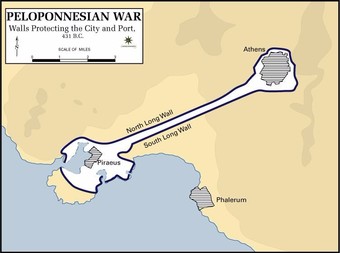
The Walls Protecting Athens
The walls protecting Athens during the Peloponnesian War.
Initially Athens’ strategy, as guided by Pericles, was to
avoid open battle with the more numerous, and better trained Spartan hoplites, and to instead rely on Athens’ superior fleet. As a result, Athens’ fleet went
on the offensive, winning a victory at Naupactus. Their victory was short-lived,
however, because in 430 BCE, an outbreak of plague hit Athens, ravaging the
densely packed city and wiping out over 30,000 citizens, sailors, and soldiers,
which amounted to roughly one-third to two-thirds of the Athenian population. As a
result, Athenian manpower was drastically reduced, and due to widespread fears
of plague, foreign mercenaries refused to hire themselves out to Athens. Sparta
also abandoned its invasion of Attica during this time, unwilling to risk
contact with their diseased enemy.
Pericles and his sons perished as a result of plague, and in
the aftermath, Athenians turned against Pericles’s defensive strategy in favor
of a more aggressive one that would bring war directly to Sparta and its
allies. Initially this strategy met with some success as Athens pursued naval
raids throughout the Peloponnese. Their successes allowed them to fortify posts
throughout the Peloponnese. One such post was near Pylos, on a tiny island
called Sphacteria. It began attracting helot runaways from Sparta, which in
turn raised Spartan fears that Athenian activities throughout the Peloponnese
would incite a mass helot revolt. As a result, the Spartans were driven into
action. During the ensuing conflicts, 300 to 400 Spartans were taken hostage,
providing Athens with a bargaining chip.
In return, the Spartans raised an army of allies and helots
and marched the length of Greece to the Athenian colony of Amphipolis, which
controlled several nearby silver mines. These mines were particularly important
because they provided much of the money that financed the Athenian war effort.
The capture of this colony provided Sparta a bargaining chip as well, and the
two rival city-states agreed to sign a truce, exchanging the Spartan hostages
for Amphipolis and its silver mines.
Peace of Nicias
The Peace of Nicias was signed in 421 BCE, concluding the
first phase of the war. Due to the loss of war hawks in both city-states during
the previous conflict, the peace endured for approximately six years. The
treaty was undermined, however, by continued fighting and calls for revolt
throughout the Peloponnese. Although the Spartans refrained from such actions
themselves, their allies remained vocal, particularly Argos. The Athenians
supported the Argives and encouraged them to form a coalition of democratic
states within the Peloponnese and separate from Sparta. Early Spartan attempts to
thwart such a coalition ultimately failed, and the Argives, their allies, and a
small Athenian force moved to seize the city of Tegea, near Sparta.
The Battle of Mantinea was the largest land battle fought
within Greece during the Peloponnesian War. The Argive allied coalition
initially utilized the sheer strength of their combined forces to score early
successes, but failed to capitalize on them, providing the elite Spartan forces
opportunities to defeat the coalition and save their city from a strategic
defeat. The Argive democratic alliance was broken up, and most members were
reincorporated into Sparta’s Peloponnesian League, reestablishing Spartan
hegemony throughout the region.
The Sicilian Expedition
During the 17th year of war, Athens received news
that one of their distant allies in Sicily was under attack from Syracuse. The
people of Syracuse were ethnically Dorian like the Spartans, and Sicily and
their allies, the Athenians, were ethnically Ionian. In 415 BCE, Athens
dispatched a massive expeditionary force to attack Syracuse in Sicily. The
Athenian force consisted of more than 100 ships, approximately 5,000
infantry, and lightly armored troops. However, their cavalry was limited to about
30 horses, which proved to be no match for the large and highly trained
Syracusan cavalry.
Meanwhile, the Syracusans petitioned Sparta for assistance in
the matter, and Sparta sent their general, Gylippus, to Sicily with reinforcements.
Subsequent Athenian attacks failed and Athens’ entire force was destroyed by
413 BCE.
The Second War
This ushered in the final phase of the war, known as the
Decelean War, or the Ionian War. By this time, Sparta was receiving support from
Persia, and Sparta bolstered rebellions in Athens’ Aegean Sea and Ionian subject
states, in order to undermine Athens empire. This eventually led to the erosion
of Athens’ naval supremacy. The Lacedaemonians were no longer content with
simply sending aid to Sicily as a means of supporting their ally. Instead, their
focus shifted to an offensive strategy against Athens. As a result, Decelea, a
town near Athens, was fortified in order to prevent the Athenians from making
use of their land year-round, and to thwart overland shipments of supplies. Nearby
silver mines were also disrupted, with Spartan hoplites freeing as many as
20,000 Athenian slaves in the vicinity. Due to this disruption in finance,
Athens was forced to demand increased tribute from its subject allies, further
increasing tension and the threat of rebellion throughout the Athenian empire.
Members of the Peloponnesian League continued to
send reinforcements to Syracuse in hopes of driving off the Athenians, but
instead, Athens sent another 100 ships and 5,000 troops to Sicily. Gylippus’s
forces, combined with those of the Syracusans, defeated the Athenians on land. The
destruction of Athens’ fleet at Aegospotami effectively ended the war, and
Athens surrendered a year later in 404 BCE. Corinth and Thebes demanded that
Athens be destroyed and all its citizens enslaved, but Sparta refused to
destroy a city that had done good service at a time of great danger to Greece,
and took Athens into their own alliance system.
7.6.2: Effects of the Peloponnesian War
Following the Peloponnesian War, Athens underwent a period
of harsh oligarchic governance and Sparta enjoyed a brief hegemonic period.
Learning Objective
Understand the effects of the Peloponnesian War on the Greek city-states
Key Points
- The Peloponnesian War ended in victory for
Sparta and its allies, but signaled the demise of Athenian naval and political
hegemony throughout the Mediterranean. - Democracy in Athens was briefly overthrown in
411 BCE as a result of its poor handling of the Peloponnesian War. Lysander,
the Spartan admiral who commanded the Spartan fleet at Aegospotami in 405 BCE, helped
to organize the Thirty Tyrants as Athens’ government for the 13 months they
maintained power. - Lysander established many pro-Spartan
governments throughout the Aegean, where the ruling classes were more loyal to
him than to Sparta as a whole. Eventually Spartan kings, Agis and Pausanias, abolished
these Aegean decarchies, curbing Lysander’s political influence. - Agesilaus II was one of two Spartan kings during
the period of Spartan hegemony, and is remembered for his multiple campaigns in
the eastern Aegean and Persian territories. - Agesilaus’s loss at the Battle of Leuctra
effectively ended Spartan hegemony throughout the region.
Key Terms
- hegemony
-
The
political, economic, or military predominance or control of one state over
others. - harmosts
-
A Spartan
term for a military governor. - oligarchy
-
A form
of power structure in which a small group of people hold all power and
influence in a state.
The Peloponnesian War ended in victory for Sparta and its
allies, and led directly to the rising naval power of Sparta. However, it
marked the demise of Athenian naval and political hegemony throughout the Mediterranean.
The destruction from the Peloponnesian War weakened and divided the Greeks for
years to come, eventually allowing the Macedonians an opportunity to conquer
them in the mid-4th century BCE.
Athens
Democracy in Athens was briefly overthrown in 411 BCE as a
result of its poor handling of the Peloponnesian War. Citizens reacted against
Athens’ defeat, blaming democratic politicians, such as Cleon and Cleophon. The
Spartan army encouraged revolt, installing a pro-Spartan oligarchy within
Athens, called the Thirty Tyrants, in 404 BCE. Lysander, the Spartan admiral who
commanded the Spartan fleet at Aegospotami in 405 BCE, helped to organize the
Thirty Tyrants as a government for the 13 months they maintained power.
During the Thirty Tyrants’ rule, five percent of the
Athenian population was killed, private property was confiscated, and
democratic supporters were exiled. The Thirty appointed a council of 500 to
serve the judicial functions that had formerly belonged to all citizens. Despite
all this, not all Athenian men had their rights removed. In fact, 3,000 such men
were chosen by the Thirty to share in the government of Athens. These men were
permitted to carry weapons, entitled to jury trial, and allowed to reside with
the city limits. This list of men was constantly being revised, and selection
was most likely a reflection of loyalty to the regime, with the majority of
Athenians not supporting the Thirty Tyrants’ rule.
Nonetheless, the Thirty’s regime was not met with much overt
opposition for the majority of their rule, as a result of the harsh penalties
placed on dissenters. Eventually, the level of violence and brutality carried
out by the Thirty in Athens led to increased opposition, stemming primarily
from a rebel group of exiles led by Thrasybulus, a former trierarch in the
Athenian navy. The increased opposition culminated in a revolution that
ultimately overthrew the Thirty’s regime. In the aftermath, Athens gave amnesty
to the 3,000 men who were given special treatment under the regime, with the
exception of those who comprised the governing Thirty and their associated
governmental officials. Athens struggled to recover from the upheaval caused by
the Thirty Tyrants in the years that followed.
Sparta
As a result of the Peloponnesian War, Sparta, which had
primarily been a continental culture, became a naval power. At its peak, Sparta
overpowered many key Greek states, including the elite Athenian navy. By the
end of the 5th century BCE, Sparta’s successes against the Athenian Empire
and ability to invade Persian provinces in Anatolia ushered in a period of
Spartan hegemony. This hegemonic period was to be short-lived, however.
Lysander
After the end of the Peloponnesian War, Lysander established
many pro-Spartan governments throughout the Aegean. Most of the ruling systems
set up by Lysander were ten-man oligarchies, called decarchies, in which
harmosts, Spartan military governors, were the heads of the government. Because
Lysander appointed from within the ruling classes of these governments, the
men were more loyal to Lysander than Sparta, making these Aegean outposts
similar to a private empire.
Lysander and Spartan king Agis were in agreement with Corinth
and Thebes that Athens should be totally destroyed in the aftermath of the
Peloponnesian War, but they were opposed by a more moderate faction, headed by
Pausanias. Eventually, Pausanias’ moderate faction gained the upper hand and
Athens was spared, though its defensive walls and port fortifications at Piraeus
were demolished. Lysander also managed to require Athens to recall its exiles,
causing political instability within the city-state, of which Lysander took
advantage to establish the oligarchy that came to be known as the Thirty
Tyrants. Because Lysander was also directly involved in the selection of the Thirty,
these men were loyal to him over Sparta, causing King Agis and King Pausanias
to agree to the abolishment of his Aegean decarchies, and eventually the
restoration of democracy in Athens, which quickly curbed Lysander’s political
influence.
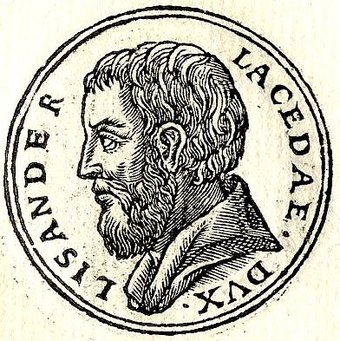
Lysander
A 16th century engraving of Lysander
Agesilaus and His Campaigns
Agesilaus II was one of two Spartan kings during the period
of Spartan hegemony. Lysander was one of Agesilaus’s biggest supporters, and was even a mentor. During his kingship, Agesilaus embarked on a number of military
campaigns in the eastern Aegean and Persian territories. During these
campaigns, the Spartans under Agesilaus’s command met with numerous rebelling
Greek poleis, including the Thebans. The Thebans, Argives, Corinthians, and Athenians
had rebelled during the Corinthian War from 395-386 BCE, and the Persians
aided the Thebans, Corinthians, and Athenians against the Spartans.
During the winter of 379/378 BCE, a group of
Theban exiles snuck into Thebes and succeeded in liberating it, despite
resistance from a 1,500-strong Spartan garrison. This led to a number of Spartan
expeditions against Thebes, known as The Boeotian War. The Greek city-states
eventually attempted to broker peace, but Theban diplomat Epaminondas angered
Agesilaus by arguing for the freedom of non-Spartan citizens within Laconia. As
a result, Agesilaus excluded the Thebans from the treaty, and the Battle of
Leuctra broke out in 371 BCE; the Spartans eventually lost. Sparta’s
international political influence precipitated quickly after their defeat.
7.7: Macedonian Conquest
7.7.1: The Rise of the Macedon
Philip II’s conquests during the Third Sacred
War cemented his power, as well as the influence of Macedon, throughout the Hellenic
world.
Learning Objective
Describe Philip II’s achievements and how he built up Macedon
Key Points
- The military skills
Philip II learned while in Thebes, coupled with his expansionist vision of
Macedonian greatness, brought him early successes when he ascended to the throne
in 359 BCE. - Philip earned
immense prestige, and secured Macedon’s position in the Hellenic world during
his involvement in the Third Sacred War, which began in Greece in 356 BCE. - War with Athens
would arise intermittently for the duration of Philip’s campaigns, due to
conflicts over land, and/or with allies. - In 337 BCE,
Philip created and led the League of Corinth, a federation of Greek states that
aimed to invade the Persian Empire. - In 336 BCE,
Philip was assassinated during the earliest stages of the League of Corinth’s Persian
venture. - Many Macedonian institutions and demonstrations
of power mirrored established Achaemenid conventions.
Key Term
- sarissas
-
A long spear or pike about 13-20 feet in length, used in ancient Greek and Hellenistic warfare, that was initially introduced by
Philip II of Macedon.
Macedon rose from a small
kingdom on the periphery of classical Greek affairs, to a dominant player in the
Hellenic world and beyond, within the span of 25 years between 359 and 336 BCE.
Macedon’s rise is largely attributable to the policies during Philip II’s rule.
Background
In the aftermath of the
Peloponnesian War, Sparta rose as a hegemonic power in classical Greece.
Sparta’s dominance was challenged by many Greek city-states who had
traditionally been independent during the Corinthian War of 395-387 BCE. Sparta
prevailed in the conflict, but only because Persia intervened on their behalf,
demonstrating the fragility with which Sparta held its power over the other
Greek city-states. In the next decade, the Thebans revolted against Sparta,
successfully liberating their city-state, and later defeating the Spartans at
the Battle of Leuctra (371 BCE). Theban general Epaminondas then led an
invasion of the Peloponnesus in 370 BCE, invaded Messenia, and liberated the
helots, permanently crippling Sparta.
These series of events
allowed the Thebans to replace Spartan hegemonic power with their own. For the
next nine years, Epaminondas and Theban general Pelopidas further extended
Theban power and influence via a series of campaigns throughout Greece,
bringing almost every city-state in Greece into the conflict. These years of
war ultimately left Greece war-weary and depleted, and during Epaminondas’s
fourth invasion of the Peloponnesus in 362 BCE, Epaminondas was killed at the
Battle of Mantinea. Although Thebes emerged victorious, their losses were
heavy, and the Thebans returned to a defensive policy, allowing Athens to
reclaim its position at the center of the Greek political system for the first
time since the Peloponnesian War. The Athenians’ second confederacy would be
Macedon’s main rivals for control of the lands of the north Aegean.
Philip II’s Accession
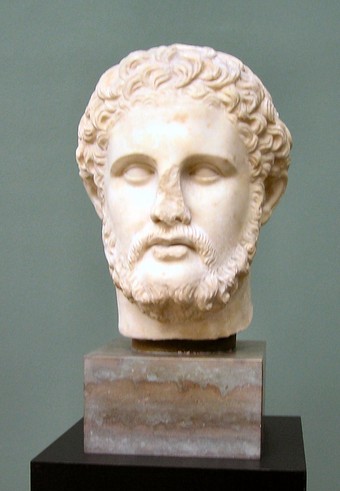
Philip II of Macedon
Bust of Philip II.
While Philip was young, he
was held hostage in Thebes, and received a military and diplomatic education
from Epaminondas. By 364 BCE, Philip returned to Macedon, and the skills he
learned while in Thebes, coupled with his expansionist vision of Macedonian
greatness, brought him early successes when he ascended to the throne in 359
BCE. When he assumed the throne, the eastern regions of Macedonia had been
sacked and invaded by the Paionians, and the Thracians and the Athenians had
landed a contingent on the coast at Methoni. Philip pushed the Paionians and
Thracians back, promising them tributes, and defeated the 3,000 Athenian hoplites
at Methoni. In the interim between conflicts, Philip focused on strengthening
his army and his overall position domestically, introducing the phalanx
infantry corps and arming them with long spears, called sarissas.
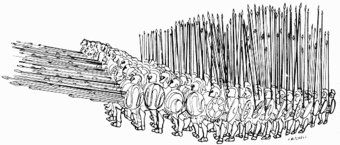
A Macedonian Phalanx
Depiction of a Macedonian phalanx armed with sarissas.
In 358 BCE, Philip marched
against the Illyrians, establishing his authority inland as far as Lake Ohrid.
Subsequently, he agreed to lease the gold mines of Mount Pangaion to the
Athenians in exchange for the return of the city of Pydna to Macedon. Ultimately,
after conquering Amphipolis in 357 BCE, he reneged on his agreement, which led
to war with Athens. During that conflict, Philip conquered Potidaea, but ceded
it to the Chalkidian League of Olynthus, with which he was allied. A year
later, he also conquered Crenides and changed its name to Philippi, using the
gold from the mines there to finance subsequent campaigns.
Third Sacred War
Philip earned immense
prestige and secured Macedon’s position in the Hellenic world during his
involvement in the Third Sacred War, which began in Greece in 356 BCE. Early in
the war, Philip defeated the Thessalians at the Battle of Crocus Field,
allowing him to acquire Pherae and Magnesia, which was the location of an
important harbor, Pagasae. He did not attempt to advance further into central
Greece, however, because the Athenians occupied Thermopylae. Although there
were no open hostilities between the Athenians and Macedonians at the time,
tensions had arisen as a result of Philip’s recent land and resource acquisitions.
Instead, Philip focused on subjugating the Balkan hill-country in the west and
north, and attacking Greek coastal cities, many of which Philip maintained
friendly relations with, until he had conquered their surrounding territories. Nonetheless,
war with Athens would arise intermittently for the duration of Philip’s
campaigns, due to conflicts over land and/or with allies.
Persian Influences
For many Macedonian rulers, the Achaemenid Empire in Persia
was a major sociopolitical influence, and Philip II was no exception. Many
institutions and demonstrations of his power mirrored established Achaemenid
conventions. For example, Philip established a Royal Secretary and Archive, as
well as the institution of Royal Pages, which would mount the king on his horse
in a manner very similar to the way in which Persian kings were mounted. He
also aimed to make his power both political and religious in nature, utilizing
a special throne stylized after those of the Achaemenid court, to demonstrate
his elevated rank. Achaemenid administrative practices were also utilized in
Macedonia rule of conquered lands, such as Thrace in 342-334 BCE.
In 337 BCE, Philip created and led the League of Corinth. Members of the
league agreed not to engage in conflict with one another unless their aim was
to suppress revolution. Another stated aim of the league was to invade the
Persian Empire. Ironically, in 336 BCE, Philip was assassinated during the
earliest stages of the Persian venture, during the marriage of his daughter
Cleopatra to Alexander I of Epirus.
7.7.2: Alexander the Great
In a little over 30 years, Alexander the Great created one of the largest empires in the ancient world, using his military and tactical genius.
Learning Objective
Examine Alexander the Great’s successes and failures
Key Points
- Alexander the Great spent most of his ruling years on an unprecedented military campaign through Asia and northeast Africa. By the age of 30, he created an empire that stretched from Greece to Egypt, and into present-day Pakistan.
- Alexander inherited a strong kingdom and experienced army, both of which contributed to his successes.
- Alexander’s legacy includes the cultural diffusion his engendered conquests, and the rise of Hellenistic culture as a result of his military campaigns.
- Alexander’s impressive record was largely due to his smart use of terrain, phalanx and cavalry tactics, bold and adaptive strategy, and the fierce loyalty of his troops.
Key Terms
- Philip II
-
A king of the Greek kingdom of Macedon from 359 BCE until his assassination in 336 BCE. He was the father of Alexander the Great.
- Alexander the Great
-
Formally Alexander III of Macedon, a Macedonian king who was undefeated in battle and is considered one of history’s most successful commanders.
- phalanx
-
A rectangular mass military formation, usually composed entirely of heavy infantry armed with spears, pikes, sarissas, or similar weapons.
Following the decline of the Greek city-states, the Greek kingdom of Macedon rose to power under Philip II. Alexander III, commonly known as Alexander the Great, was born to Philip II in Pella in 356 BCE, and succeeded his father to the throne at the age of 20. He spent most of his ruling years on an unprecedented military campaign through Asia and northeast Africa, and by the age of 30, had created one of the largest empires of the ancient world, which stretched from Greece to Egypt and into present-day Pakistan. He was undefeated in battle and is considered one of history’s most successful commanders.
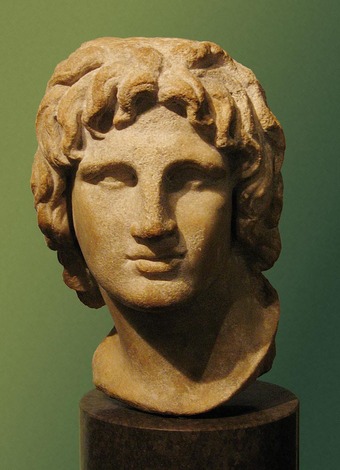
Alexander the Great
Bust of a young Alexander the Great from the Hellenistic era, now at the British Museum.
During his youth, Alexander was tutored by the philosopher Aristotle, until the age of 16. When he succeeded his father to the throne in 336 BCE, after Philip was assassinated, Alexander inherited a strong kingdom and an experienced army. He had been awarded the generalship of Greece, and used this authority to launch his father’s military expansion plans. In 334 BCE, he invaded the Achaemenid Empire, ruled Asia Minor, and began a series of campaigns that lasted ten years. Alexander broke the power of Persia in a series of decisive battles, most notably the battles of Issus and Gaugamela. He overthrew the Persian King Darius III, and conquered the entirety of the Persian Empire. At that point, his empire stretched from the Adriatic Sea to the Indus River.
Seeking to reach the “ends of the world and the Great Outer Sea,” he invaded India in 326 BCE, but was eventually forced to turn back at the demand of his troops. Alexander died in Babylon in 323 BCE, the city he planned to establish as his capital, without executing a series of planned campaigns that would have begun with an invasion of Arabia. In the years following his death, a series of civil wars tore his empire apart, resulting in several states ruled by the Diadochi, Alexander’s surviving generals and heirs. Alexander’s legacy includes the cultural diffusion his engendered conquests. He founded some 20 cities that bore his name, the most notable being Alexandria in Egypt. Alexander’s settlement of Greek colonists, and the spread of Greek culture in the east, resulted in a new Hellenistic civilization, aspects of which were still evident in the traditions of the Byzantine Empire in the mid-15th century. Alexander became legendary as a classical hero in the mold of Achilles, and he features prominently in the history and myth of Greek and non-Greek cultures. He became the measure against which military leaders compared themselves, and military academies throughout the world still teach his tactics.
Military Generalship
Alexander earned the honorific epithet “the Great” due to his unparalleled success as a military commander. He never lost a battle, despite typically being outnumbered. His impressive record was largely due to his smart use of terrain, phalanx and cavalry tactics, bold strategy, and the fierce loyalty of his troops. The Macedonian phalanx, armed with the sarissa, a spear up to 20 feet long, had been developed and perfected by Alexander’s father, Philip II. Alexander used its speed and maneuverability to great effect against larger, but more disparate, Persian forces. Alexander also recognized the potential for disunity among his diverse army, due to the various languages, cultures, and preferred weapons individual soldiers wielded. He overcame the possibility of unrest among his troops by being personally involved in battles, as was common among Macedonian kings.
In his first battle in Asia, at Granicus, Alexander used only a small part of his forces—
perhaps 13,000 infantry, with 5,000 cavalry—against a much larger Persian force of 40,000. Alexander placed the phalanx at the center, and cavalry and archers on the wings, so that his line matched the length of the Persian cavalry line. By contrast, the Persian infantry was stationed behind its cavalry. Alexander’s military positioning ensured that his troops would not be outflanked; further, his phalanx, armed with long pikes, had a considerable advantage over the Persians’ scimitars and javelins. Macedonian losses were negligible compared to those of the Persians.
At Issus in 333 BCE, his first confrontation with Darius, he used the same deployment, and again the central phalanx pushed through. Alexander personally led the charge in the center and routed the opposing army. At the decisive encounter with Alexander at Gaugamela, Darius equipped his chariots with scythes on the wheels to break up the phalanx and equipped his cavalry with pikes. Alexander in turn arranged a double phalanx, with the center advancing at an angle, which parted when the chariots bore down and reformed once they had passed. The advance proved successful and broke Darius’s center, and Darius was forced to retreat once again.
When faced with opponents who used unfamiliar fighting techniques, such as in Central Asia and India, Alexander adapted his forces to his opponents’ style. For example, in Bactria and Sogdiana, Alexander successfully used his javelin throwers and archers to prevent outflanking movements, while massing his cavalry at the center. In India, confronted by Porus’s elephant corps, the Macedonians opened their ranks to envelop the elephants, and used their sarissas to strike upwards and dislodge the elephants’ handlers.
7.7.3: Alexander’s Empire
Alexander the Great’s legacy was the dissemination of Greek culture throughout Asia.
Learning Objective
Describe the legacy Alexander left within his conquered territories
Key Points
- Alexander’s campaigns greatly increased contacts and trade between the East and West, and vast areas to the east were significantly exposed to Greek civilization and influence. Successor states remained dominant for the next 300 years during the Hellenistic period.
- Over the course of his conquests, Alexander founded some 20 cities that bore his name, and these cities became centers of culture and diversity. The most famous of these cities is Egypt’s Mediterranean port of Alexandria.
- Hellenization refers to the spread of Greek language, culture, and population into the former Persian empire after Alexander’s conquest.
- Alexander’s death was sudden and his empire disintegrated into a 40-year period of war and chaos in 321 BCE. The Hellenistic world eventually settled into four stable power blocks: the Ptolemaic Kingdom of Egypt, the Seleucid Empire in the east, the Kingdom of Pergamon in Asia Minor, and Macedon.
Key Term
- Hellenization
-
The spread of Greek language, culture, and population into the former Persian empire after Alexander’s conquests.
Alexander’s legacy extended beyond his military conquests. His campaigns greatly increased contacts and trade between the East and West, and vast areas to the east were exposed to Greek civilization and influence. Some of the cities he founded became major cultural centers, and many survived into the 21st century. His chroniclers recorded valuable information about the areas through which he marched, while the Greeks themselves attained a sense of belonging to a world beyond the Mediterranean.
Hellenistic Kingdoms
Alexander’s most immediate legacy was the introduction of Macedonian rule to huge swathes of Asia. Many of the areas he conquered remained in Macedonian hands or under Greek influence for the next 200 to 300 years. The successor states that emerged were, at least initially, dominant forces, and this 300 year period is often referred to as the Hellenistic period.
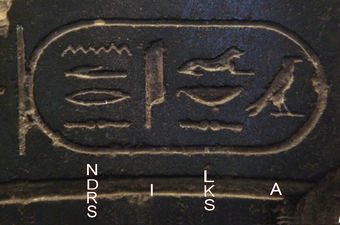
Alexander’s name in hieroglyphics
Name of Alexander the Great in Egyptian hieroglyphs (written from right to left), c. 330 BCE, Egypt; Louvre Museum.
The eastern borders of Alexander’s empire began to collapse during his lifetime. However, the power vacuum he left in the northwest of the Indian subcontinent directly gave rise to one of the most powerful Indian dynasties in history. Taking advantage of this, Chandragupta Maurya (referred to in Greek sources as Sandrokottos), of relatively humble origin, took control of the Punjab, and with that power base proceeded to conquer the Nanda Empire.
Hellenization
The term
“Hellenization” was coined to denote the spread of Greek language,
culture, and population into the former Persian empire after Alexander’s
conquest. Alexander deliberately pursued Hellenization policies in the
communities he conquered. While his intentions may have simply been to
disseminate Greek culture, it is more likely that his policies were pragmatic
in nature and intended to aid in the rule of his enormous empire via cultural
homogenization. Alexander’s Hellenization policies can also be viewed as a
result of his probable megalomania. Later his successors explicitly rejected these
policies. Nevertheless, Hellenization occurred throughout the region,
accompanied by a distinct and opposite “Orientalization” of the successor
states.
The core of
Hellenistic culture was essentially Athenian. The close association of men from
across Greece in Alexander’s army directly led to the emergence of the largely
Attic-based koine (or
“common”) Greek dialect. Koine spread
throughout the Hellenistic world, becoming the lingua
franca of
Hellenistic lands, and eventually the ancestor of modern Greek. Furthermore,
town planning, education, local government, and art during the Hellenistic
periods were all based on classical Greek ideals, evolving into distinct new
forms commonly grouped as Hellenistic.
The Founding of Cities
Over the course of his conquests, Alexander founded some 20 cities that bore his name, most of them east of the Tigris River. The first, and greatest, was Alexandria in Egypt, which would become one of the leading Mediterranean cities. The cities’ locations reflected trade routes, as well as defensive positions. At first, the cities must have been inhospitable, and little more than defensive garrisons. Following Alexander’s death, many Greeks who had settled there tried to return to Greece. However, a century or so after Alexander’s death, many of these cities were thriving with elaborate public buildings and substantial populations that included both Greek and local peoples.
Alexander’s cities were
most likely intended to be administrative headquarters for his empire,
primarily settled by Greeks, many of whom would have served in Alexander’s
military campaigns. The purpose of these administrative centers was to control the
newly conquered subject populations. Alexander attempted to create a unified
ruling class in conquered territories like Persia, often using marriage ties to
intermingle the conquered with conquerors. He also adopted elements of the Persian
court culture, adopting his own version of their royal robes, and imitating some
court ceremonies. Many Macedonians resented these policies, believing
hybridization of Greek and foreign cultures to be irreverent.
Alexander’s attempts at
unification also extended to his army. He placed Persian soldiers, some of who
had been trained in the Macedonian style, within Macedonian ranks, solving
chronic manpower problems.
Division of the Empire
Alexander’s death was so sudden that when reports of his death reached Greece, they were not immediately believed. Alexander had no obvious or legitimate heir because his son, Alexander IV, was born after Alexander’s death. According to Diodorus, an ancient Greek historian, Alexander’s companions asked him on his deathbed to whom he bequeathed his kingdom. His laconic reply was, tôi kratistôi (“to the strongest”). Another, more plausible, story claims that Alexander passed his signet ring to Perdiccas, a bodyguard and leader of the companion cavalry, thereby nominating him as his official successor.
Perdiccas initially did not claim power, instead suggesting that Alexander’s unborn baby would be king, if male. He also offered himself, Craterus, Leonnatus, and Antipater, as guardians of Alexander’s unborn child. However, the infantry rejected this arrangement since they had been excluded from the discussion. Instead, they supported Alexander’s half-brother, Philip Arrhidaeus, as Alexander’s successor. Eventually the two sides reconciled, and after the birth of Alexander IV, Perdiccas and Philip III were appointed joint kings, albeit in name only.
Dissension and rivalry soon afflicted the Macedonians. After the assassination of Perdiccas in 321 BCE, Macedonian unity collapsed, and 40 years of war between “The Successors” (Diadochi) ensued, before the Hellenistic world settled into four stable power blocks: the Ptolemaic Kingdom of Egypt, the Seleucid Empire in the east, the Kingdom of Pergamon in Asia Minor, and Macedon. In the process, both Alexander IV and Philip III were murdered.
7.7.4: The Legacy of Alexander the Great
Four stable power blocks emerged following the
death of Alexander the Great: the Ptolemaic Kingdom of Egypt, the Seleucid
Empire, the Attalid Dynasty of the Kingdom of Pergamon, and Macedon.
Learning Objective
Evaluate Alexander the Great’s legacy as carried
out by his successors
Key Points
- After the assassination of Perdiccas in 321 BCE,
Macedonian unity collapsed, and 40 years of war between “The
Successors” (Diadochi) ensued
before the Hellenistic world settled into four stable power blocks: the
Ptolemaic Kingdom of Egypt, the Seleucid Empire, the Kingdom of Pergamon in
Asia Minor, and Macedon. - The Ptolemaic Kingdom was ruled by the Ptolemaic
dynasty, starting with Ptolemy I Soter’s accession to the throne following the
death of Alexander the Great. The dynasty survived until the death of Cleopatra
VII in 30 BCE, at which point Egypt was conquered by the Romans. - Although the Ptolemaic Kingdom observed the Egyptian
religion and customs, Greek inhabitants were treated as a privileged minority. - The Seleucid Empire was a major center of
Hellenistic culture where Greek customs prevailed and the Greek political elite
dominated, though mostly in urban areas. - The Attalid kingdom of Pergamon began as a rump
state, but was expanded by subsequent rulers. - The Attalids were some of the most loyal
supporters of Rome in the Hellenistic world and were known for their generous and
intelligent rule. - The Macedonian regime
is the only successor state to Alexander the Great’s empire that maintained
archaic perceptions of kingship, and elided the adoption of Hellenistic
monarchical customs.
Key Terms
- satrap
-
A governor of a province in the Hellenistic
empire. The word is also used metaphorically to refer to leaders who are
heavily influenced by larger superpowers or hegemonies, and regionally act as a surrogate
for those larger players. - proskynesis
-
A traditional Persian act of bowing or prostrating oneself before a
person of higher social rank.
Background
Alexander’s death was so sudden that when reports of his
death reached Greece, they were not immediately believed. Alexander had no
obvious or legitimate heir because his son, Alexander IV, was born after
Alexander’s death. According to Diodorus, an ancient Greek historian,
Alexander’s companions asked him on his deathbed to whom he bequeathed his
kingdom. His laconic reply was tôi kratistôi (“to the
strongest”). Another, more plausible, story claims that Alexander passed
his signet ring to Perdiccas, a bodyguard and leader of the companion cavalry, thereby
nominating him as his official successor.
Perdiccas initially did not claim power, instead suggesting
that Alexander’s unborn baby would be king, if male. He also offered himself,
Craterus, Leonnatus, and Antipater, as guardians of Alexander’s unborn child.
However, the infantry rejected this arrangement since they had been excluded
from the discussion. Instead, they supported Alexander’s half-brother, Philip
Arrhidaeus, as Alexander’s successor. Eventually the two sides reconciled, and
after the birth of Alexander IV, Perdiccas and Philip III were appointed joint
kings, albeit in name only.
Dissension and rivalry soon afflicted the
Macedonians. After the assassination of Perdiccas in 321 BCE, Macedonian unity
collapsed, and 40 years of war between “The Successors” (Diadochi) ensued before the
Hellenistic world settled into four stable power blocks: the Ptolemaic Kingdom
of Egypt, the Seleucid Empire in the east, the Kingdom of Pergamon in Asia
Minor, and Macedon. In the process, both Alexander IV and Philip III were
murdered.
The Ptolemaic Kingdom of Egypt
The Ptolemaic Kingdom was a Hellenistic kingdom
based in Egypt, and ruled by the Ptolemaic dynasty, starting with Ptolemy I Soter’s
accession to the throne following the death of Alexander the Great. The
Ptolemaic dynasty survived until the death of Cleopatra VII in 30 BCE, at which
point Egypt was conquered by the Romans. Ptolemy was appointed as satrap of
Egypt in 323 BCE, by Perdiccas during the succession crisis that erupted
following Alexander the Great. From that time, Ptolemy ruled Egypt nominally in
the name of joint kings Philip III and Alexander IV. As Alexander the Great’s
empire disintegrated, however, Ptolemy established himself as a ruler in his
own right. In 321 BCE, Ptolemy defended Egypt against an invasion by Perdiccas.
During the Wars of the Diadochi (322-301 BCE), Ptolemy further consolidated his
position within Egypt and the region by taking the title of King.
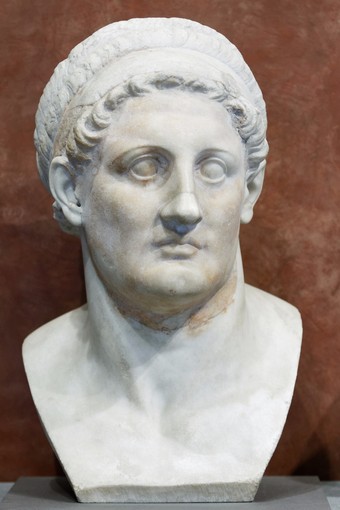
Ptolemy I Soter
Bust of Ptolemy I Soter, king of Egypt (305-282 BCE) and founder of the Ptolemaic dynasty. The identification is based upon coin effigies.
Early in the Ptolemaic dyansty, Egyptian religion
and customs were observed, and magnificent new temples were built in the style
of the old pharaohs. During the reign of Ptolemies II and III, thousands of
Macedonian veterans were rewarded with farm land grants, and settled in colonies
and garrisons throughout the country. Within a century, Greek influence had
spread throughout the country and intermarriage produced a large Greco-Egyptian
educated class. Despite this, the Greeks remained a privileged minority in Ptolemaic
Egypt. Greek individuals lived under Greek law, received a Greek education,
were tried in Greek courts, and were citizens of Greek cities, rather than
Egyptian cities.
The Seleucid Empire
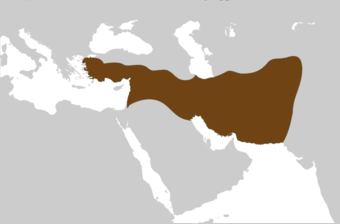
Seleucid Empire
Seleucid Empire at its greatest extent, 281 BCE.
The Seleucid Empire was a Hellenistic state ruled
by the Seleucid Dynasty, which existed from 312 BCE-63 BCE. It was founded
by Seleucus I Nicator following the dissolution of Alexander the Great’s
empire. Following Ptolemy’s successes in the Wars of the Diadochi, Seleucus,
then a senior officer in the Macedonian Royal Army, received Babylonia. From
there, he expanded his dominion to include much of Alexander’s near eastern
territories. At the height of its power, the Seleucid Empire encompassed central
Anatolia, Persia, the Levant, Mesopotamia, and what is now Kuwait, Afghanistan,
and parts of Pakistan and Turkmenistan. Seleucus himself traveled as far as
India in his campaigns. Seleucid expansion into Anatolia and Greece was halted,
however, after decisive defeats at the hands of the Roman army.
The Seleucid Empire was a major center of
Hellenistic culture, where Greek customs prevailed and the Greek political elite
dominated, though mostly in urban areas. Existing Greek populations within the
empire were supplemented with Greek immigrants.
The Kingdom of Pergamon
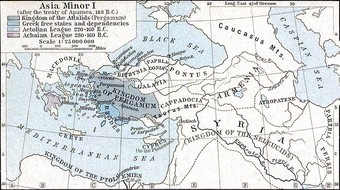
Asia Minor, 188 BCE
The Kingdom of Pergamon (colored olive), shown at its greatest extent in 188 BCE.
The ancient Greek city of Pergamon was taken by
Lysimachus, King of Thrace, in 301 BCE, a short-lived possession that ended
when the kingdom of Thrace collapsed. It became the capital of a new kingdom of
Pergamon, which Philetaerus founded in 281 BCE, thus beginning the rule of the
Attalid Dynasty. The Attalid kingdom began as a rump state, but was expanded by
subsequent rulers. The Attalids themselves were some of the most loyal
supporters of Rome in the Hellenistic world. Under Attalus I (r. 241-197 BCE),
the Attalids allied with Rome against Philip V of Macedon, during the first and
second Macedonian Wars. They allied with Rome again under Eumenes II (r. 197-158
BCE) against Perseus of Macedon, during the Third Macedonian War. Additionally,
in exchange for their support against the Seleucids, the Attalids were given
all former Seleucid domains in Asia Minor.
The Attalids were known for their intelligent and
generous rule. Many historical documents from the era demonstrate that the
Attalids supported the growth of towns by sending in skilled artisans and remitting
taxes. They also allowed Greek cities to maintain nominal independence and sent
gifts to Greek cultural sites, such as Delphi, Delos, and Athens, and even remodeled the Acropolis of Pergamon after the Acropolis in Athens. When Attalus III (r. 138-133
BCE) died without an heir, he bequeathed his entire kingdom to Rome to prevent civil
war.
Macedon

The Kingdom of Macedon at the death of Philip II (336 BCE)
Macedon, or Macedonia, was the dominant state of
Hellenistic Greece. In the partition of Alexander’s empire among the Diadochi,
Macedon fell to the Antipatrid Dynasty, which was headed by Antipater and his
son, Cassander. Following Cassander’s death in 297 BCE, Macedon slid into a long
period of civil strife. Antigonus II (r. 277-239 BCE) successfully restored
order and prosperity in the region, and established a stable monarchy under the
Antigonid Dynasty, though he lost control of many Greek city-states in the process.
Notably, the Macedonian regime is the only
successor state to Alexander the Great’s empire that maintained archaic
perceptions of kingship, and elided the adoption of Hellenistic monarchical
customs. The Macedonian king was never deified in the same way that kings of the
Ptolemaic and Seleucid Dynasties had been. Additionally, the custom of proskynesis,
a traditional Persian act of bowing or prostrating oneself before a person of
higher social rank, was never adopted. Instead, Macedonian subjects addressed
their kings in a far more casual manner, and kings still consulted with their
aristocracy in the process of making decisions.
During the reigns of
Philip V (r. 221-179 BCE) and his son Perseus (r. 179-168 BCE), Macedon clashed
with the rising Roman republic. During the 2nd and 1st centuries BCE, Macedon
fought a series of wars against Rome. Two decisive defeats in 197 and 168 BCE
resulted in the deposition of the Antigonid Dynasty, and the dismantling of the
kingdom of Macedon.
